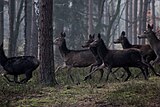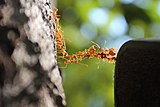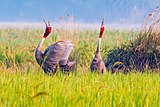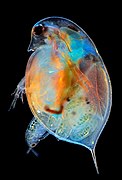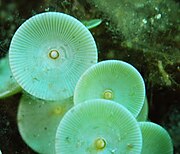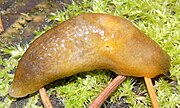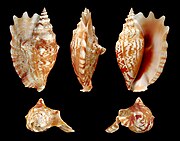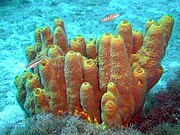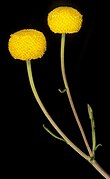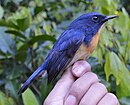Welcome!
Hello, Capra walie, and welcome to Misplaced Pages! Thank you for your contributions. I hope you like the place and decide to stay. Here are a few links to pages you might find helpful:
- Getting started
- Introduction to Misplaced Pages
- The five pillars of Misplaced Pages
- How to edit a page and How to develop articles
- How to create your first article
- Simplified Manual of Style
Please remember to sign your messages on talk pages by typing four tildes (~~~~); this will automatically insert your username and the date. If you need help, check out Misplaced Pages:Questions, ask me on my talk page, or ask your question on this page and then place {{Help me}} before the question. Again, welcome!
If you are interesting in me showing you around coding stuff such as taxoboxes and cladograms, feel free to contact my talk page, just like I said on your IPs talk page. Also, if you are interested in a more all-round wikipedian mentoring you, feel free to visit WP:Adopt-a-user, or, if you have questions about wikipedia policies please visit WP:Teahouse. Any questions about dinosaur articles or references can be added to WT:DINO. Hope you enjoy editing as a user - IJReid (talk) 01:09, 13 April 2014 (UTC)
List of creatures in Primeval
As a recent contributor at List of creatures in Primeval your input to a discussion at Talk:List of creatures in Primeval#Removal of substantial amounts of content would be appreciated. Thank you. --AussieLegend (✉) 17:48, 21 July 2014 (UTC)
Lourinha Formation paleobiota
Hi Capra. I am currently working on an illustration of the Lourinha Formation including the dinosaurs Dinheirosaurus lourinhanensis, Torvosaurus gurneyi, Allosaurus europaeus, Draconyx loureiroi, and Lusotitan atalaiensis. I am not asking for your critique on this, as I will post it on the image review page once the pencil version is done, but I was wondering what other organisms (plants, mammals, other dinosaurs) should be added to the image. An extremely bad image of this so far can be found here (note, the actual image is reversed). The Lusotitan and Draconyx, in successive order from right closer to left farther (on the real image). Are there any taxa to add to the image, or any minor comments at this stage? Just wondering, but is a collaboration between us on the Lourinha page and taxa possible, although noting that I will be on vacation from the 13th to the 21st, because some genera, like Dinheirosaurus, are actually quite close to being good articles soon? IJReid (talk) 02:37, 7 August 2014 (UTC)
- Ah, I have now also put online a newer version of my current illustration, although the resolution is still crappy. The link is here. IJReid (talk) 02:45, 7 August 2014 (UTC)
- Ok. As for notes on the current state, perhaps adding one or two more Lusotitan behind the current one, representing a small herd, as opposed to a loner. Adding another Draconyx with the current one as well. The only other thing I would think to change about the current creatures would be that the living Torvosaurus would be looking up at the Dinheirosaurus as opposed to tending to it's dead/dying relative (Sibling? Parent? Mate?). As for other taxa, I'd try not to overcrowd the image, so maybe some Dryosaurus, and a Miragaia or Dacentrurus. Also, it may be odd to have the Allosaurus and Torvosaurus attacking the same sauropod, so maybe have the Allosaurus attacking Dryosaurus or Miragaia/Dacentrurus mentioned above. Just some ideas thought. As for non-dinosaurs and plants, I've not gotten to the point of researching Lourinha Formation flora or non-dinosaur fauna yet, so I'm not sure. I'll have to get back to you on that, thought ferns and generic conifers are a safe bet for now.
- As for collaboration, I'm open to the idea. Perhaps you could more work on the taxa pages, to avoid any edit conflicts. First thing that needs attending to, I don't think the Richardoestesia page makes any mention that Jurassic Portuguese material from various formations has been assigned to it, so make mention of that, thought note that the identification is tentative and the teeth probably don't belong to it but an unknown relative. Don't bother with the Deltapodus page thought, I plan on re-doing (i.e. essentially writing.) that page after I finish with Lourinha anyway. All references in the article are open access papers except 1 and 3, and the addtional references section, so there should be plenty of sources to go off of. Thought if you can find any more open access refs for Lusotitan or Lourinhasaurus that would be greatly appreciated.
- Also, FYI, I've had a username change from Capra walie to Lusotitan.
- Thanks. Lusotitan (talk) 14:28, 7 August 2014 (UTC)
- Hi again Luso. I have updated the image again, and again, when using my webcam the image appeared with a crappy resolution. The link is here. I have taken some of your requests into consideration, and have some comments on them. I haven't yet added more Lusotitan, Draconyx, or other ornithischians, but I think the Ornithischians will be in a herd together, as suggested by the paired footprints of ornithopods and stegosaurs. I think I will keep the theropods as they are, because what if the Allosaurus was attacking the Dinheirosaurus, which made the Dinheirosaurus rear up, an then the sauropod mistook some passing Torvosaurus as attacking, so it squished one of them. The Torvosaurus doesn't want to become aggressive with the Dinheirosaurus, as the Allosaurus is stronger, more powerful, larger, and bulkier than it, and it wouldn't end well for the Torvosaurus. On the left side of my image is a broken tree trunk with a pterosaur walking along it. I will say the pterosaur is Harpactognathus, which is found in the Morrison, so it is possible its range included Portugal. The pterosaur will be waiting for a partially exposed lizard to come fully out of the log to eat it. I have also added another tree that is possible to have existed in the Lourinha Formation behind the will be herd of ornithischians. I will start our collaboration as soon as the pencil image is done and I have completed User:Reid,iain james/Draft:Parasaurolophus, which you can help on as well. Bye for now, IJReid (talk) 15:06, 7 August 2014 (UTC)
- Torvosaurus guryeni is actually larger then Allosaurus europaeus, but I assume these are not full grown then, so no problem I guess. However, I have thought of, not a problem, but an idea. Replacing the Dinheirosaurus with a Zby. As it is currently, all of the fauna have very close relatives in the Morrison. And although it is correct the two formations are very similar, including in fauna, there are differences. The two big faunal differences that come to mind are the lack of low browsing sauropods (Maybe. Complicated issue.) and the presence of a turiasaur. Having a Miragaia and Zby will do a great job at representing that the formation is unique. Just an idea.Lusotitan (talk) 16:53, 7 August 2014 (UTC)
Merry Christmas!

Oh, you'd better watch out, you'd better not cry, you'd better not pout, I'm telling you why Christmas Velociraptor is coming to town He sees you when you sleeping, he knows when you're awake, he knows if you've been bad or good, so be good for your life's sake Oh, you'd better watch out, you'd better not cry, you'd better not pout, I'm telling you why Christmas Velociraptor is coming to town
|
Disambiguation link notification for March 4
Hi. Thank you for your recent edits. Misplaced Pages appreciates your help. We noticed though that when you edited Erpetonyx, you added a link pointing to the disambiguation page Pennsylvanian. Such links are almost always unintended, since a disambiguation page is merely a list of "Did you mean..." article titles. Read the FAQ • Join us at the DPL WikiProject.
It's OK to remove this message. Also, to stop receiving these messages, follow these opt-out instructions. Thanks, DPL bot (talk) 09:29, 4 March 2015 (UTC)
Disambiguation link notification for July 10
Hi. Thank you for your recent edits. Misplaced Pages appreciates your help. We noticed though that when you edited Protohippus, you added a link pointing to the disambiguation page Calippus. Such links are almost always unintended, since a disambiguation page is merely a list of "Did you mean..." article titles. Read the FAQ • Join us at the DPL WikiProject.
It's OK to remove this message. Also, to stop receiving these messages, follow these opt-out instructions. Thanks, DPL bot (talk) 08:55, 10 July 2015 (UTC)
Disambiguation link notification for November 18
Hi. Thank you for your recent edits. Misplaced Pages appreciates your help. We noticed though that when you edited List of dinosaur genera, you added a link pointing to the disambiguation page Lepidus. Such links are almost always unintended, since a disambiguation page is merely a list of "Did you mean..." article titles. Read the FAQ • Join us at the DPL WikiProject.
It's OK to remove this message. Also, to stop receiving these messages, follow these opt-out instructions. Thanks, DPL bot (talk) 10:55, 18 November 2015 (UTC)
Disambiguation link notification for April 17
Hi. Thank you for your recent edits. Misplaced Pages appreciates your help. We noticed though that when you edited Sinopeltosaurus, you added a link pointing to the disambiguation page ICZN. Such links are almost always unintended, since a disambiguation page is merely a list of "Did you mean..." article titles. Read the FAQ • Join us at the DPL WikiProject.
It's OK to remove this message. Also, to stop receiving these messages, follow these opt-out instructions. Thanks, DPL bot (talk) 10:18, 17 April 2016 (UTC)
May 2016
![]() Hello, I'm Oshwah. I noticed that you recently removed some content from Dandakosaurus with this edit, without adequately explaining why. In the future, it would be helpful to others if you described your changes to Misplaced Pages with an edit summary. If this was a mistake, don't worry, the removed content has been restored. If you think I made a mistake, or if you have any questions, you can leave me a message on my talk page. Thanks. ~Oshwah~ 00:19, 1 May 2016 (UTC)
Hello, I'm Oshwah. I noticed that you recently removed some content from Dandakosaurus with this edit, without adequately explaining why. In the future, it would be helpful to others if you described your changes to Misplaced Pages with an edit summary. If this was a mistake, don't worry, the removed content has been restored. If you think I made a mistake, or if you have any questions, you can leave me a message on my talk page. Thanks. ~Oshwah~ 00:19, 1 May 2016 (UTC)
Disambiguation link notification for May 1
Hi. Thank you for your recent edits. Misplaced Pages appreciates your help. We noticed though that when you edited List of dinosaur genera, you added a link pointing to the disambiguation page Diceratops. Such links are almost always unintended, since a disambiguation page is merely a list of "Did you mean..." article titles. Read the FAQ • Join us at the DPL WikiProject.
It's OK to remove this message. Also, to stop receiving these messages, follow these opt-out instructions. Thanks, DPL bot (talk) 11:17, 1 May 2016 (UTC)
ArbCom Elections 2016: Voting now open!
Hello, Lusotitan. Voting in the 2016 Arbitration Committee elections is open from Monday, 00:00, 21 November through Sunday, 23:59, 4 December to all unblocked users who have registered an account before Wednesday, 00:00, 28 October 2016 and have made at least 150 mainspace edits before Sunday, 00:00, 1 November 2016.
The Arbitration Committee is the panel of editors responsible for conducting the Misplaced Pages arbitration process. It has the authority to impose binding solutions to disputes between editors, primarily for serious conduct disputes the community has been unable to resolve. This includes the authority to impose site bans, topic bans, editing restrictions, and other measures needed to maintain our editing environment. The arbitration policy describes the Committee's roles and responsibilities in greater detail.
If you wish to participate in the 2016 election, please review the candidates' statements and submit your choices on the voting page. MediaWiki message delivery (talk) 22:08, 21 November 2016 (UTC)
Your recent edits
![]() Hello and welcome to Misplaced Pages. When you add content to talk pages and Misplaced Pages pages that have open discussion (but never when editing articles), please be sure to sign your posts. There are two ways to do this. Either:
Hello and welcome to Misplaced Pages. When you add content to talk pages and Misplaced Pages pages that have open discussion (but never when editing articles), please be sure to sign your posts. There are two ways to do this. Either:
- Add four tildes ( ~~~~ ) at the end of your comment; or
- With the cursor positioned at the end of your comment, click on the signature button (
 or
or  ) located above the edit window.
) located above the edit window.
This will automatically insert a signature with your username or IP address and the time you posted the comment. This information is necessary to allow other editors to easily see who wrote what and when.
Thank you. --SineBot (talk) 02:40, 1 September 2017 (UTC)
A page you started (Matheronodon) has been reviewed!
Thanks for creating Matheronodon, Lusotitan!
Misplaced Pages editor Boleyn just reviewed your page, and wrote this note for you:
This has been tagged for one issue and has one empty section.
To reply, leave a comment on Boleyn's talk page.
Learn more about page curation.
Boleyn (talk) 07:28, 27 October 2017 (UTC)
Signature
Hi -- I noticed when reading one of your recent comments that you don't have a link to your user page or user talk page in your signature. This is rather an nuisance for other editors -- see WP:SIGLINK for the relevant guideline. Would you mind putting a link back into your signature? Thanks. Mike Christie (talk - contribs - library) 12:41, 4 November 2017 (UTC)
- Lusotitan, I see you haven't changed your signature. Would you mind adding a link? Per WP:SIGLINK, it is regarded as obstructive not to have a link to your user page or talk page in your signature. Mike Christie (talk - contribs - library) 11:52, 6 November 2017 (UTC)
- How do I add one? Lusotitan 19:53, 6 November 2017 (UTC)
- Go to Special:Preferences and you'll see the Signature section on the User profile tab. There are instructions there; if you get stuck leave a note here and I can help. Mike Christie (talk - contribs - library) 20:52, 6 November 2017 (UTC)
- How do I add one? Lusotitan 19:53, 6 November 2017 (UTC)
ArbCom 2017 election voter message
Hello, Lusotitan. Voting in the 2017 Arbitration Committee elections is now open until 23.59 on Sunday, 10 December. All users who registered an account before Saturday, 28 October 2017, made at least 150 mainspace edits before Wednesday, 1 November 2017 and are not currently blocked are eligible to vote. Users with alternate accounts may only vote once.
The Arbitration Committee is the panel of editors responsible for conducting the Misplaced Pages arbitration process. It has the authority to impose binding solutions to disputes between editors, primarily for serious conduct disputes the community has been unable to resolve. This includes the authority to impose site bans, topic bans, editing restrictions, and other measures needed to maintain our editing environment. The arbitration policy describes the Committee's roles and responsibilities in greater detail.
If you wish to participate in the 2017 election, please review the candidates and submit your choices on the voting page. MediaWiki message delivery (talk) 18:42, 3 December 2017 (UTC)
Signature again
Lusotitan, I see you still haven't added a link to your user page in your signature. Can you take another look at the section above and let me know if you need help doing this? See WP:SIGLINK for the reason why this should be done. Mike Christie (talk - contribs - library) 19:59, 3 December 2017 (UTC)`
- Still don't have two clues how to do it. Lusotitan 22:54, 3 December 2017 (UTC)
- I can't do it for you directly, but I can tell you what to do. Go to Special:Preferences, and about halfway down you'll see an input box that says "Signature:". Copy everything in the box, and post it here, but do it like this:
<nowiki>...</nowiki>
- with whatever's in that input box where I put the dots. (If you don't put it in those "nowiki" tags, it'll convert the text to your signature, which is not what I need to see.) I'll then be able to tell you what to put into that box to fix it. Mike Christie (talk - contribs - library) 23:29, 3 December 2017 (UTC)
- Wait, does it work now? Lusotitan' 03:14, 4 December 2017 (UTC)
- That's much better -- it now links to your user page. Thank you for doing that. A lot of people like to leave a link to their talk page, instead of, or as well as, the link to their user page, since it's usually the talk page they want to get to. But that's up to you. Mike Christie (talk - contribs - library) 03:18, 4 December 2017 (UTC)
- Done. Lusotitan (Talk | Contributions) 03:24, 4 December 2017 (UTC)
- Thanks! Mike Christie (talk - contribs - library) 03:36, 4 December 2017 (UTC)
- Done. Lusotitan (Talk | Contributions) 03:24, 4 December 2017 (UTC)
- That's much better -- it now links to your user page. Thank you for doing that. A lot of people like to leave a link to their talk page, instead of, or as well as, the link to their user page, since it's usually the talk page they want to get to. But that's up to you. Mike Christie (talk - contribs - library) 03:18, 4 December 2017 (UTC)
- Wait, does it work now? Lusotitan' 03:14, 4 December 2017 (UTC)
- with whatever's in that input box where I put the dots. (If you don't put it in those "nowiki" tags, it'll convert the text to your signature, which is not what I need to see.) I'll then be able to tell you what to put into that box to fix it. Mike Christie (talk - contribs - library) 23:29, 3 December 2017 (UTC)
Heads Up
Just to let you know, that IP that added that "Extinct animals of Korea" category to various articles is a long-term vandal who haunts that IP range, spamming articles with inappropriate, nonexistent, and nonexistent and inappropriate categories. The standard procedure is to revert literally every edit it makes as per WP:DENY, as the vandal's edits can not be trusted due to a combination of poor writing, eagerness to insert original research nonsense, and general incompetence.--Mr Fink (talk) 04:05, 23 December 2017 (UTC)
DYK nomination of Sibirotitan
![]() Hello! Your submission of Sibirotitan at the Did You Know nominations page has been reviewed, and some issues with it may need to be clarified. Please review the comment(s) underneath your nomination's entry and respond there as soon as possible. Thank you for contributing to Did You Know! Chris857 (talk) 04:57, 3 January 2018 (UTC)
Hello! Your submission of Sibirotitan at the Did You Know nominations page has been reviewed, and some issues with it may need to be clarified. Please review the comment(s) underneath your nomination's entry and respond there as soon as possible. Thank you for contributing to Did You Know! Chris857 (talk) 04:57, 3 January 2018 (UTC)
Signature causing problems at DYK
Lusotitan, I figured out what part of your signature was causing problems at DYK - the pipe character "|" between talk and contribs. Templates use the pipe to separate template arguments. You could change the pipe character to something else, or wrap it in nowiki tags like so: <nowiki>|</nowiki>. And your nomination is good to go. Chris857 (talk) 15:15, 5 January 2018 (UTC)
- Thanks for the heads up, I put in the nowiki tags. Lusotitan (Talk | Contributions) 15:36, 5 January 2018 (UTC)
DYK for Sibirotitan
On 20 January 2018, Did you know was updated with a fact from the article Sibirotitan, which you recently created, substantially expanded, or brought to good article status. The fact was ... that the newly named dinosaur Sibirotitan is only the second sauropod species named from the country of Russia, and one of the oldest titanosauriform sauropod species known from all of Asia? The nomination discussion and review may be seen at Template:Did you know nominations/Sibirotitan. You are welcome to check how many page hits the article got while on the front page (here's how, Sibirotitan), and it may be added to the statistics page if the total is over 5,000. Finally, if you know of an interesting fact from another recently created article, then please feel free to suggest it on the Did you know talk page.
— Coffee // have a ☕️ // beans // 14:32, 20 January 2018 (UTC)
That section
The Tarbosaurus section was fine not bad there some research on the piece.
New popular culture for Tarbosaurs
A Tarbosaurus was the main character in Speckles: The Tarbosaurus (The Dino King). Tarbosaurus also appears in the BBC documentaries Chased by Dinosaur were it fights with Therizinosaurus and The Truth About Killer Dinosaurs where it was seen hunting an Ankylosaurus. Tarbosaurus is seen in the imax Documentary Dinosaurs Alive where it fights Tarchia. Tarbosaurus is in Mongolian Post it stamps. Tarbosaurus appears in books toys. Tarbosaurus appeared in the game Dinosaur King.
- "IMDB Dinosaur King".
- "BBC Nature Tarbosaurus".
- "Dinosaurs Alive IMDB".
- "Paleophilatelie.EDU".
- "wikidata Dinosaur King WIKI".
Can i please add this one instead. Tarbosaurus Appearance in media is pretty prevalent — Preceding unsigned comment added by Bubblesorg (talk • contribs) at 04:36, 14 May 2018 (UTC)
Good you keep track
This Alex guy is just adding stuff without referencing to Hyperodapedon, with spelling mistakes, he just doesn't seem to care. Good you do. Cheers, Tisquesusa (talk) 05:00, 19 May 2018 (UTC)
Dinosaur articles as part of Wikiproject Paleontology
Hi Lusotitan, I have seen you have removed the wikiproject Paleontology banner from Neovenator talk page, however pretty much every dinosaur article has both a dual wikiproject dinosaurs and paleontology on the talk page (Baryonyx is the only one I can find that only has wikiproject dinosaurs for whatever reason), I find it a bit bizarre to just remove it from the neovenator article, given that the vast majority of articles have both. Thus I have reverted your decision for the meantime. If dinosaurs are going have their wikiproject paleontology banners removed, and thus be excised from the scope of wikiproject paleontology this is quite a huge change and is going have to be discussed on the wikiproject paleontology talk page. Kind regards Hemiauchenia (talk) 21:39, 20 May 2018 (UTC)
- It's already a guideline over on the WikiProject page, after being discussed previously. The practice just never got properly implemented. Quoting the WikiProject page:
- "Since there is already a dedicated palaeontology project, only dinosaur articles that are important to the subject of paleontology in general should be tagged by that project, since all dinosaur articles are already paleontology articles by default."
- Lusotitan (Talk | Contributions) 22:06, 20 May 2018 (UTC)
- Do you have a direct link the quote and discussion? How does one define "important to the subject of paleontology in general"? That's really vague, does that only apply to taxa important to the development of paleontology in general, like Megalosaurus and Iguanodon? Iconic taxa like Tyrannosaurus and Triceratops?. Or important 'transitional' fossils like Archaeopteryx and Microraptor?. If this is going to be done, "important to the subject of paleontology in general" needs to be specifically defined by community consensus on the wikiproject paleontology talk page, the vagueness of the criteria is probably why it wasn't done previously. Hemiauchenia (talk) 22:16, 20 May 2018 (UTC)
- I've found the link to the quote, but that is on the wikiproject dinosaur page, whether or not a page is part of wikiproject paleontology should only ultimately be the result of wikiproject paleontology guidelines, what the wikiproject dinosaur page says is pretty much irrelevant to that. If wikiproject paleontology links are going to be removed from dinosaur articles this needs to be discussed with wikiproject paleontology members on their project talk page Hemiauchenia (talk) 22:35, 20 May 2018 (UTC)
- Well, it's how we treat other things. Everyone agrees putting the "Dinosaurs" category on Neovenator would be excessive, since there's already a carcharodontosaurids category we put it in. That automatically also categorizes it as a dinosaur, since all carcharodontosaurids are dinosaurs. Likewise, every article in WikiProject Dinosaurs falls under paleontology since WikiProject Dinosaurs is within WikiProject Paleontology. If we need to ask WikiProject Paleontology whether we can have them excluded, why not ask WikiProject Geology? That's the exact same thing, we've just moved it up a layer.
- I've found the link to the quote, but that is on the wikiproject dinosaur page, whether or not a page is part of wikiproject paleontology should only ultimately be the result of wikiproject paleontology guidelines, what the wikiproject dinosaur page says is pretty much irrelevant to that. If wikiproject paleontology links are going to be removed from dinosaur articles this needs to be discussed with wikiproject paleontology members on their project talk page Hemiauchenia (talk) 22:35, 20 May 2018 (UTC)
- Regarding the discussion, it seems the discussion on it on the WikiProject Dinosaurs talkpage wasn't archived properly, I can only find it by looking at the editing history.Lusotitan (Talk | Contributions) 22:48, 20 May 2018 (UTC)
- You haven't answered my question. What does "important to the subject of paleontology in general" mean in your opinion? you've just made it out like that wikiproject paleontology should be removed from all dinosaur articles, which is not what the original quote implied. The wikiprojects =/= categories, and having another wikiproject in the talk page does not significantly clutter it. like adding neovenator directly to the dinosaur category would. incidentally the category "dinosaurs" from my brief look at it seems like a wastebasket anyway, and it's subcategory list of dinosaur genera, and dinosaurs by continent are an absolute mess with bizzarely small list of dinosaur taxa and a smaller subcategory of monotypic dinosaur genera despite virtually all dinosaur genera being monotypic. anyways wikiproject dinosaurs is not within wikiproject paleontology, if it was it would be a taskforce. Wikiproject paleontology in turn is not part of wikiproject geology. they are all in fact sister projects. It just seems weird to do it to just Neovenator, when there is nothing about Neovenator in particular that warrants it being removed from wikiproject paleontology over hundreds of other dinosaur articles. If you are going to do this you'd need to be consistent and remove it from hundreds of other dinosaur articles which should not be done unilaterally, but instead discussed with other users on the wikiproject paleontology talkpage, paging FunkMonk for discussion. Hemiauchenia (talk) 23:30, 20 May 2018 (UTC)
- I wasn't singling out Neovenator. I happened to be on its talk page and decided to enforce the rule. I do a similar thing with updating the portal link templates at the bottom of every dinosaur page; instead of taking the huge timesink to do it to every page at once, systematically, just do it when I happen to be editing anyways. Lusotitan (Talk | Contributions) 00:32, 21 May 2018 (UTC)
- What I meant back during the dfiscussion and in the guideline is that dinosaur articles are already inherently palaeontology articles. So a dinosaur article doens't need to be tagged with the palaeo project if it isn't somehow important to palaentology in genera. Megalosaurus is important to the history of palaeontology, whereas say, Mojoceratops, isn't really. But there are of course borderline cases. FunkMonk (talk) 22:05, 21 May 2018 (UTC)
- I wasn't singling out Neovenator. I happened to be on its talk page and decided to enforce the rule. I do a similar thing with updating the portal link templates at the bottom of every dinosaur page; instead of taking the huge timesink to do it to every page at once, systematically, just do it when I happen to be editing anyways. Lusotitan (Talk | Contributions) 00:32, 21 May 2018 (UTC)
- You haven't answered my question. What does "important to the subject of paleontology in general" mean in your opinion? you've just made it out like that wikiproject paleontology should be removed from all dinosaur articles, which is not what the original quote implied. The wikiprojects =/= categories, and having another wikiproject in the talk page does not significantly clutter it. like adding neovenator directly to the dinosaur category would. incidentally the category "dinosaurs" from my brief look at it seems like a wastebasket anyway, and it's subcategory list of dinosaur genera, and dinosaurs by continent are an absolute mess with bizzarely small list of dinosaur taxa and a smaller subcategory of monotypic dinosaur genera despite virtually all dinosaur genera being monotypic. anyways wikiproject dinosaurs is not within wikiproject paleontology, if it was it would be a taskforce. Wikiproject paleontology in turn is not part of wikiproject geology. they are all in fact sister projects. It just seems weird to do it to just Neovenator, when there is nothing about Neovenator in particular that warrants it being removed from wikiproject paleontology over hundreds of other dinosaur articles. If you are going to do this you'd need to be consistent and remove it from hundreds of other dinosaur articles which should not be done unilaterally, but instead discussed with other users on the wikiproject paleontology talkpage, paging FunkMonk for discussion. Hemiauchenia (talk) 23:30, 20 May 2018 (UTC)
on your next edit
On your next edit. Please in your edit summary ask sutt to come to the discussion page so we can ask him a couple of question. I did read our response and i did look at richard sutt. Signs of a very underpriced wikipedia. SHould we offer him up some help?????? Also please ask them to make a user and talk page.
This is my talk page (User talk: Richard.sutt)Richard.sutt (talk) 20:20, 17 June 2018 (UTC)
Pachyrhinosaurus
I just wanted to ask why it's unncessary to add both parents. Pachyrostra is lower than Pachyrhinosaurini would'nt that be important to indicate? (User talk: Richard.sutt))Richard.sutt (talk) 20:20, 17 June 2018 (UTC)
- As long as Pachyrostra is displayed readers can click on the link to see that groups parents. It also saves the taxonboxes from taking up an unreasonable amount of vertical space. IJReid 14:35, 18 June 2018 (UTC)
Permission to add Pachyrostra to the Ceratopsidae template
May I? (User talk: Richard.sutt)
Logged out
Hi. Was this you? The vote has a user-like signature, but it was not made with an account. Cheers, Manifestation (talk) 13:29, 6 July 2018 (UTC)
- This was not me. It seems the IP just copied the signature code from a nearby comment, which happened to be mine. Lusotitan (Talk | Contributions) 15:34, 6 July 2018 (UTC)
- Oh ok. I've messaged the anon in question. Thanks, Manifestation (talk) 18:28, 6 July 2018 (UTC)
Speciesbox and monotypic genera
Replying here to not further derail the discussion at WP:TOL. I'm not sure what you're seeing with Saurophaganax. Are you viewing it in mobile mode? For me, in non-mobile view, the genus, species, and binomial lines are bold and not clickable, and putting the cursor on them does nothing. In mobile mode, the genus is not bolded, and it kind of acts like a link; while I can't click on it, when I put the cursor on it, it gets underlined like links do. Is that what you're talking about? Plantdrew (talk) 18:38, 11 July 2018 (UTC)
- I'm not in mobile mode but that it what it's displaying on my end. Lusotitan (Talk | Contributions) 18:41, 11 July 2018 (UTC)
- Wait, apparently it's a browser thing. It displays bold in Chrome but not Firefox. Lusotitan (Talk | Contributions) 18:42, 11 July 2018 (UTC)
- Huh. I'm using Firefox 61. It is getting underlined when you put the cursor on it? There does seem to be some sort of problem with self-links in mobile mode (so far I've only tested with going to the mobile page on a desktop computer with Firefox). I'm finding that any self-link (not just in taxoboxes) is not bold and gets underlined when the cursor is placed on it in mobile mode. Of course, there really aren't very many self-links on Misplaced Pages; taxoboxes for monotypic taxa are one of the few places they show up. Plantdrew (talk) 18:51, 11 July 2018 (UTC)
- Yeah, they underline when hovered over but don't actually work. Lusotitan (Talk | Contributions) 18:53, 11 July 2018 (UTC)
- Well, it seems to be a bug in how the page is rendered. I've brought it up at Misplaced Pages:Village pump (technical)#Self-links not bolded in certain viewing configurations. Plantdrew (talk) 19:13, 11 July 2018 (UTC)
- Yeah, they underline when hovered over but don't actually work. Lusotitan (Talk | Contributions) 18:53, 11 July 2018 (UTC)
- Huh. I'm using Firefox 61. It is getting underlined when you put the cursor on it? There does seem to be some sort of problem with self-links in mobile mode (so far I've only tested with going to the mobile page on a desktop computer with Firefox). I'm finding that any self-link (not just in taxoboxes) is not bold and gets underlined when the cursor is placed on it in mobile mode. Of course, there really aren't very many self-links on Misplaced Pages; taxoboxes for monotypic taxa are one of the few places they show up. Plantdrew (talk) 18:51, 11 July 2018 (UTC)
Your edits on Irritator
Thanks for your recent edits to the Irritator article! I'd noticed a few of those issues before, but was a bit reluctant/unsure of how to fix them. Also yeah, I have GA and FA plans for this article in light of the Museu Nacional fire. FunkMonk is doing the same with Thalassodromeus, which hails from the same formation as Irritator, you might remember from our discussion at the WikiProject Palaeontology page. There's still a lot of work left to do though if it's going to be comprehensive enough for FA, I just got my hands on the Angaturama paper so its description will be filled in pretty soon. And of course there's the postcranial specimens as well, which Machado and Kellner have described in various papers. ▼PσlєοGєєкƧɊƲΔƦΣƉ▼ 22:23, 19 September 2018 (UTC)
DYK for Ledumahadi
On 4 November 2018, Did you know was updated with a fact from the article Ledumahadi, which you recently created, substantially expanded, or brought to good article status. The fact was ... that during its time 200 million years ago, Ledumahadi's weight of 12 tonnes (26,000 lb) made it the largest animal to have lived on Earth? The nomination discussion and review may be seen at Template:Did you know nominations/Ledumahadi. You are welcome to check how many page hits the article got while on the front page (here's how, Ledumahadi), and it may be added to the statistics page if the total is over 5,000. Finally, if you know of an interesting fact from another recently created article, then please feel free to suggest it on the Did you know talk page.
Cas Liber (talk · contribs) 00:02, 4 November 2018 (UTC)
ArbCom 2018 election voter message
Hello, Lusotitan. Voting in the 2018 Arbitration Committee elections is now open until 23.59 on Sunday, 3 December. All users who registered an account before Sunday, 28 October 2018, made at least 150 mainspace edits before Thursday, 1 November 2018 and are not currently blocked are eligible to vote. Users with alternate accounts may only vote once.
The Arbitration Committee is the panel of editors responsible for conducting the Misplaced Pages arbitration process. It has the authority to impose binding solutions to disputes between editors, primarily for serious conduct disputes the community has been unable to resolve. This includes the authority to impose site bans, topic bans, editing restrictions, and other measures needed to maintain our editing environment. The arbitration policy describes the Committee's roles and responsibilities in greater detail.
If you wish to participate in the 2018 election, please review the candidates and submit your choices on the voting page. MediaWiki message delivery (talk) 18:42, 19 November 2018 (UTC)
Tyrannosaurus
Hi, are you still going to shorten the feeding section? LittleJerry (talk) 22:41, 21 November 2018 (UTC)
- I will at some point. Lusotitan (Talk | Contributions) 00:08, 22 November 2018 (UTC)
Take part in a survey
Hi Lusotitan
We're working to measure the value of Misplaced Pages in economic terms. We want to ask you some questions about how you value being able to edit Misplaced Pages.
Our survey should take about 10-15 minutes of your time. We hope that you will enjoy it and find the questions interesting. All answers will be kept strictly confidential and will be anonymized before the aggregate results are published. Regretfully, we can only accept responses from people who live in the US due to restrictions in our grant-based funding.
As a reward for your participation, we will randomly pick 1 out of every 5 participants and give them $25 worth of goods of their choice from the Misplaced Pages store (e.g. Misplaced Pages themed t-shirts). Note that we can only reward you if you are based in the US.
Click here to access the survey: https://mit.co1.qualtrics.com/jfe/form/SV_eXJcEhLKioNHuJv
Thanks
Avi
Researcher, MIT Initiative on the Digital Economy --Avi gan (talk) 02:13, 28 November 2018 (UTC)
Deinonychosauria
Hi, I didn't link Deinonychosauria in Xixiasaurus before because it is now a redirect to Dromaeosauridae. But thinking about this, making it a redirect was probably not sound in the first place, since the term still seems to be used by some researchers. Furthermore, I don't even think Dromaeosauridae would be the right place to redirect it... Should it maybe be restored? FunkMonk (talk) 03:23, 11 December 2018 (UTC)
- Well, it still redirects to a subsection on the topic, but yes, it feels out of place there. Makes more sense to direct it to the relationships section of Paraves or give it a short page explaining the model and its validity. Lusotitan (Talk | Contributions) 03:43, 11 December 2018 (UTC)
A page you started (Gobiraptor) has been reviewed!
Thanks for creating Gobiraptor.
I have just reviewed the page, as a part of our page curation process and note that:
Nice work; thanks for creating this!
Do note that it's generally a good idea to have more than one source on any page; in this case, I've added a reference to the Wiener Zeitung and expanded the article a tiny bit using that source. Also, you shouldn't rate articles you create as FA on the quality scale; this status is reserved for featured articles that have gone through a thorough review.
Let me know if you have any questions. Cheers and happy editing!
To reply, leave a comment here and prepend it with {{Re|SkyGazer 512}}. And, don't forget to sign your reply with ~~~~ .
Message delivered via the Page Curation tool, on behalf of the reviewer.
SkyGazer 512 01:07, 7 February 2019 (UTC)
- @SkyGazer 512: Oops, copied over WikiProject code and forgot to change the rating. Regarding the second source, news article sources are generally highly discouraged in WP:DINO due to the poor quality of science journalism (as appears to be the case... they never suggest it ate crustaceans in the paper itself, which the article is entirely based on). Lusotitan (Talk | Contributions) 01:10, 7 February 2019 (UTC)
- Thanks for the response! Regarding the rating, that's completely understandable; mistakes happen. :) I apologize for not realizing that about the news articles sources; it certainly is something I should have thought of. Feel absolutely free to revert my edit if you'd like.--SkyGazer 512 01:12, 7 February 2019 (UTC)
DYK for Weewarrasaurus
On 12 February 2019, Did you know was updated with a fact from the article Weewarrasaurus, which you recently created, substantially expanded, or brought to good article status. The fact was ... that the first discovered fossil of the dinosaur Weewarrasaurus was noted for being preserved in green-blue opal? The nomination discussion and review may be seen at Template:Did you know nominations/Weewarrasaurus. You are welcome to check how many page hits the article got while on the front page (here's how, Weewarrasaurus), and it may be added to the statistics page if the total is over 5,000. Finally, if you know of an interesting fact from another recently created article, then please feel free to suggest it on the Did you know talk page.
– Amakuru (talk) 00:01, 12 February 2019 (UTC)
Map size
I made it equal with the taxobox on my screen resolution and size, but apparently that varies quite a bit. Would be nice to automate that, but I don't know how that would work. Tisquesusa (talk) 17:26, 18 February 2019 (UTC)
Dubious genera
The automated taxobox system doesn't support dubious genera with names written with ".."; for example it can't at present abbreviate "Tanius" to "T." So I think a manual taxobox is best at "Tanius" laiyangensis. Peter coxhead (talk) 21:47, 18 February 2019 (UTC)
- Addendum: there is another way of handling questionable generic assignments, by using ? rather than ".." – see Tortrix? destructus. This method is supported by the automated taxobox system. Peter coxhead (talk) 21:58, 18 February 2019 (UTC)
- Inapplicable, as there is no doubt that the species doesn't belong to Tanius. Lusotitan (Talk | Contributions) 22:20, 18 February 2019 (UTC)
DYK for Bajadasaurus
| On 4 March 2019, Did you know was updated with a fact from the article Bajadasaurus, which you recently nominated. The fact was ... that Bajadasaurus had elongated neural spines on its neck, thought to have been used to deter predators? The nomination discussion and review may be seen at Template:Did you know nominations/Bajadasaurus. You are welcome to check how many page hits the article got while on the front page (here's how, daily totals), and it may be added to the statistics page if the total is over 5,000. Finally, if you know of an interesting fact from another recently created article, then please feel free to suggest it on the Did you know talk page. |
— Amakuru (talk) 00:02, 4 March 2019 (UTC)
About Galleonosaurus
Hi Lusotitan,
I am puzzled why you removed references from BBC News and ABC News (Australia) from that article in this edit. They are without doubt reliable sources.
Given that this species and its genus was only recently described, it would appear to me that this might be a DYK candidate, with those references to support it.
Please let me know if I can assist you in any way about improving the English language Misplaced Pages.
Pete AU aka --Shirt58 (talk) 09:51, 16 March 2019 (UTC)
- Press releases are not reliable at all when it comes to palaeontology, anything that doesn't butcher the ideas of the given paper is a rare surprise. They should be avoided unless there is some information about the discovery or history that the literature is unable to provide. When the article can be sourced only with peer reviewed papers written by experts and not repurposes of that exact same source written by someone with no idea what they're talking about, that's ideal, and it's the case here. Now, both this articles look pretty fine, there's no grave errors; but there's no information that can't be gleaned from the far more reliable source of the paper which the articles are merely re-statements of to begin with. There's no need for them. If you want to argue pointless news sources should be used in dinosaur articles against years of precedence, go argue it at the talk for WP:DINO. Lusotitan (Talk | Contributions) 15:57, 16 March 2019 (UTC)
Your edit on Tanis (fossil site)
I reverted this addition - sorry.
The reason is, that this is an article on the site. It is not a biographical article on its discoverer, any more than the article on Chicxulub is an article on its discoverer and all that's said about him in the media. There's a lot to write, and this is not really stuff that belongs.
The other problem is that the New Yorker is a single source. It has a somewhat dramatic approach which may mean its coverage isn't exactly balanced - but we don't have good other sources for significant views on the matters you added, which they have claimed, to compare with. And if we did, we'd put them in a BLP, not here - and then only if he himself becomes notable which is not yet clear. Last, as it has a negative tone, the concerns about poorly sourced negative BLPs are relevant.
For all these reasons, I've removed the text, which is virtually a rehash of the New Yorker's description. It may be that we will have an article on him. But it won't be this one.
When he becomes notable, and we have other good sources, you might want to create it :) FT2 02:02, 4 April 2019 (UTC)
- If you feel this is not important than his whole section should be removed, it's for the most part even less important. The Museum described is directly relevant and this reflects on his reputation as a palaeontologist, which is rather important. Also, I included a second source, ScienceMag, which featured a quote not present in the New Yorker article, so it's not just coming from them (something I know already since I've heard of controversy surrounding him before, but that's irrelevant). Also, why the image removal? It's relevant to the adjacent text and there's nothing else to put there. Lusotitan (Talk | Contributions) 02:10, 4 April 2019 (UTC)
WikiProject Tree of Life Newsletter
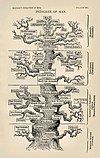
- April 2019—Issue 001
- Tree of Life
- Welcome to the inaugural issue of the Tree of Life newsletter!
|
|
|
|
- WikiCup heating up
Tree of Life editors are making a respectable showing in this year's WikiCup, with three regular editors advancing to the third round. Overall winner from 2016, Casliber, topped the scoreboard in points for round 2, getting a nice bonus for bringing Black mamba to FA. Enwebb continues to favor things remotely related to bats, bringing Stellaluna to GA. Plants editor Guettarda also advanced to round 3 with several plant-related DYKs.
- Misplaced Pages page views track animal migrations, flowers blooming
A March 2019 paper in PLOS Biology found that Misplaced Pages page views vary seasonally for species. With a dataset of 31,751 articles about species, the authors found that roughly a quarter of all articles had significant seasonal variations in page views on at least one language version of Misplaced Pages. They examined 245 language versions. Page views also peaked with cultural events, such as views of the Great white shark article during Shark Week or Turkey during Thanksgiving.

- Did you know ... that Tree of Life editors bring content to the front page nearly every day?
* ... that Dippy is the most famous dinosaur skeleton in the world? (1 April)
|
You are receiving this because you added your name to the subscribers list of the WikiProject Tree of Life. If you no longer wish to receive the newsletter, please remove your name.
MediaWiki message delivery (talk) 16:24, 7 May 2019 (UTC)
Question about the removal of taxa
Hey um, I do not want to come off as rude, but. Why exactly are you reverting my edits on adding in ornithopod genera? Some of them are indeed valid. OviraptorFan (talk) 12:07, 10 May 2019 (UTC)
- Invalid or dubious taxa don't get put in taxoboxes. I'm not aware of taking away any valid ones. Lusotitan (Talk | Contributions) 19:38, 10 May 2019 (UTC)
May 2019 Tree of Life Newsletter

- May 2019—Issue 002
- Tree of Life
- Welcome to the Tree of Life newsletter!
|
|
|
|
- Fundamental changes being discussed at WikiProject Biology
On 23 May, user Prometheus720 created a talk page post, "Revamp of Wikiproject Biology--Who is In?". In the days since, WP:BIOL has been bustling with activity, with over a dozen editors weighing in on this discussion, as well as several others that have subsequently spawned. An undercurrent of thought is that WP:BIOL has too many subprojects, preventing editors from easily interacting and stopping a "critical mass" of collaboration and engagement. Many mergers and consolidations of subprojects have been tentatively listed, with a consolidation of WikiProjects Genetics + Molecular and Cell Biology + Computational Biology + Biophysics currently in discussion. Other ideas being aired include updating old participants lists, redesigning project pages to make them more user-friendly, and clearly identifying long- and short-term goals.
- Editor Spotlight: These editors want you to write about dinosaurs
Editors FunkMonk and Jens Lallensack had a very fruitful month, collaborating to bring two dinosaur articles to GA and then nominating them both for FA. They graciously decided to answer some questions for the first ToL Editor Spotlight, giving insight to their successful collaborations, explaining why you should collaborate with them, and also sharing some tidbits about their lives off-Misplaced Pages.
1) Enwebb: How long have you two been collaborating on articles?
- Jens Lallensack: I started in the German Misplaced Pages in 2005 but switched to the English Misplaced Pages because of its very active dinosaur project. My first major collaboration with FunkMonk was on Heterodontosaurus in 2015.
- FunkMonk: Yeah, we had interacted already on talk pages and through reviewing each other's articles, and at some point I was thinking of expanding Heterodontosaurus, and realised Jens had already written the German Misplaced Pages version, so it seemed natural to work together on the English one. Our latest collaboration was Spinophorosaurus, where by another coincidence, I had wanted to work on that article for the WP:Four Award, and it turned out that Jens had a German book about the expedition that found the dinosaur, which I wouldn't have been able to utilise with my meagre German skills. Between those, we also worked on Brachiosaurus, a wider Dinosaur Project collaboration between several editors.
2) Enwebb: Why dinosaurs?
- JL: Because of the huge public interest in them. But dinosaurs are also highly interesting from a scientific point of view: key evolutionary innovations emerged within this group, such as warm-bloodedness, gigantism, and flight. Dinosaur research is, together with the study of fossil human remains, the most active field in paleontology. New scientific techniques and approaches tend to get developed within this field. Dinosaur research became increasingly interdisciplinary, and now does not only rely on various fields of biology and geology, but also on chemistry and physics, among others. Dinosaurs are therefore ideal to convey scientific methodology to the general public.
- FM: As outlined above, dinosaurs have been described as a "gateway to science"; if you learn about dinosaurs, you will most likely also learn about a lot of scientific fields you would not necessarily be exposed to otherwise. On a more personal level, having grown up with and being influenced by various dinosaur media, it feels pretty cool to help spread knowledge about these animals, closest we can get to keeping them alive.
3) Enwebb: Why should other editors join you in writing articles related to paleontology? Are you looking to attract new editors, or draw in experienced editors from other areas of Misplaced Pages?
- JL: Because we are a small but active and helpful community. Our Dinosaur collaboration, one of the very few active open collaborations in Misplaced Pages, makes high-level writing on important articles easier and more fun. Our collaboration is especially open to editors without prior experience in high-level writing. But we do not only write articles: several WikiProject Dinosaur participants are artists who do a great job illustrating the articles, and maintain an extensive and very active image review system. In fact, a number of later authors started with contributing images.
- FM: Anyone who is interested in palaeontology is welcome to try writing articles, and we would be more than willing to help. I find that the more people that work on articles simultaneously with me, the more motivation I get to write myself. I am also one of those editors who started out contributing dinosaur illustrations and making minor edits, and only began writing after some years. But when I got to it, it wasn't as intimidating as I had feared, and I've learned a lot in the process. For example anatomy; if you know dinosaur anatomy, you have a very good framework for understanding the anatomy of other tetrapod animals, including humans.
4) Enwebb: Between the two of you, you have over 300 GA reviews. FunkMonk, you have over 250 of those. What keeps you coming back to review more articles?
- FM: One of the main reasons I review GANs is to learn more about subjects that seem interesting (or which I would perhaps not come across otherwise). There are of course also more practical reasons, such as helping an article on its way towards FAC, to reduce the GAN backlog, and to "pay back" when I have a nomination up myself. It feels like a win-win situation where I can be entertained by interesting info, while also helping other editors get their nominations in shape, and we'll end up with an article that hopefully serves to educate a lot of people (the greater good).
- JL: Because I enjoy reading Misplaced Pages articles and like to learn new things. In addition, reviews give me the opportunity to have direct contact with the authors, and help them to make their articles even better. This is quite rewarding for me personally. But I also review because I consider our GA and FA system to be of fundamental importance for Misplaced Pages. When I started editing Misplaced Pages (the German version), the article promotion reviews motivated me and improved my writing skills a lot. Submitting an article for review requires one to get serious and take additional steps to bring the article to the best quality possible. GAs and FAs are also a good starting point for readers, and may motivate them to become authors themselves.
5) Enwebb: What are your editing preferences? Any scripts or gadgets you find invaluable?
- FM: One script that everyone should know about is the duplink highlight tool. It will show duplinks within the intro and body of a given article separately, and it seems a lot of people still don't know about it, though they are happy when introduced to it. I really liked the citationbot too (since citation consistency is a boring chore to me), but it seems to be blocked at the moment due to some technical issues.
- JL: I often review using the Misplaced Pages Beta app on my smartphone, as it allows me to read without needing to sit in front of the PC. For writing, I find the reference management software Zotero invaluable, as it generates citation templates automatically, saving a lot of time.
- Editor's note: I downloaded Zotero and tried it for the first time and think it is a very useful tool. More here.
6) Enwebb: What would surprise the ToL community to learn about your life off-wiki?
- FM: Perhaps that I have no background in natural history/science, but work with animation and games. But fascination with and knowledge of nature and animals is actually very helpful when designing and animating characters and creatures, so it isn't that far off, and I can actually use some of the things I learn while writing here for my work (when I wrote the Dromaeosauroides article, it was partially to learn more about the animal for a design-school project).
- JL: That I am actually doing research on dinosaurs. Though I avoid writing about topics I publish research on, my Misplaced Pages work helps me to keep a good general overview over the field, and quite regularly I can use what I learned while writing for Misplaced Pages for my research.
Get in touch with these editors regarding collaboration at WikiProject Dinosaurs!
- Marine life continues to dominate ToL DYKs
|
You are receiving this because you added your name to the subscribers list of the WikiProject Tree of Life. If you no longer wish to receive the newsletter, please remove your name.
Sent by DannyS712 (talk) using MediaWiki message delivery (talk) at 03:44, 4 June 2019 (UTC)
June 2019 Tree of Life Newsletter

- June 2019—Issue 003
- Tree of Life
- Welcome to the Tree of Life newsletter!
|
|
|
|
| Project name | Relative WikiWork |
|---|---|
| Cats | 4.79 |
| Fisheries and fishing | 4.9 |
| Dogs | 4.91 |
| Viruses | 4.91 |
| ToL | 4.94 |
| Cetaceans | 4.97 |
| Primates | 4.98 |
| Sharks | 5.04 |
| All wikiprojects average | 5.05 |
| Dinosaurs | 5.12 |
| Equine | 5.15 |
| Bats | 5.25 |
| Mammals | 5.32 |
| Aquarium fishes | 5.35 |
| Hypericaceae | 5.38 |
| Turtles | 5.4 |
| Birds | 5.46 |
| Australian biota | 5.5 |
| Marine life | 5.54 |
| Animals | 5.56 |
| Paleontology | 5.57 |
| Rodents | 5.58 |
| Amphibians and Reptiles | 5.64 |
| Fungi | 5.65 |
| Bivalves | 5.66 |
| Plants | 5.67 |
| Algae | 5.68 |
| Arthropods | 5.69 |
| Hymenoptera | 5.72 |
| Microbiology | 5.72 |
| Cephalopods | 5.74 |
| Fishes | 5.76 |
| Ants | 5.79 |
| Gastropods | 5.8 |
| Spiders | 5.86 |
| Insects | 5.9 |
| Beetles | 5.98 |
| Lepidoptera | 5.98 |
- Spineless editors overwhelmed by stubs
Within the Tree of Life and its many subprojects, there is an abundance of stubs. Welcome to Misplaced Pages, what's new, right? However, based on all wikiprojects listed (just over two thousand), the Tree of Life project is worse off in average article quality than most. Based on the concept of relative WikiWork (the average number of "steps" needed to have a project consisting of all featured articles (FAs), where stub status → FA consists of six steps), only seven projects within the ToL have an average rating of "start class" or better. Many projects, particularly those involving invertebrates, hover at an average article quality slightly better than a stub. With relative WikiWorks of 5.98 each, WikiProject Lepidoptera and WikiProject Beetles have the highest relative WikiWork of any project. Given that invertebrates are incredibly speciose, it may not surprise you that many articles about them are lower quality. WikiProject Beetles, for example, has over 20 times more articles than WikiProject Cats. Misplaced Pages will always be incomplete, so we should take our relatively low WikiWork as motivation to write more articles that are also better in quality.
- Editor Spotlight: Showing love to misfit taxa
We're joined for this month's Editor Spotlight by NessieVL, a long-time contributor who lists themselves as a member of WikiProject Fungus, WikiProject Algae, and WikiProject Cephalopods.
1) Enwebb: How did you come to edit articles about organisms and taxonomic groups?
- Nessie: The main force, then and now, driving me to create or edit articles is thinking "Why isn't there an article on that on Misplaced Pages?" Either I'll read about some rarely-sighted creature in the deep sea or find something new on iNaturalist and want to learn more. First stop (surprise!) is Misplaced Pages, and many times there is just a stub or no page at all. Sometimes I just add the source that got me to the article, not sometimes I go deep and try to get everything from the library or online journals and put it all in an article. The nice thing about taxa is the strong precedent that all accepted extant taxa are notable, so one does not need to really worry about doing a ton of research and having the page get removed. I was super worried about this as a new editor: I still really dislike conflict so if I can avoid it I do. Anyway, the most important part is stitching an article in to the rest of Misplaced Pages: Linking all the jargon, taxonomers, pollinators, etc., adding categories, and putting in the correct WikiProjects. Recently I have been doing more of the stitching-in stuff with extant articles. The last deep-dive article I made was Karuka at the end of last year, which is a bit of a break for me. I guess it's easier to do all the other stuff on my tablet while watching TV.
2) Enwebb: Many editors in the ToL are highly specialized on a group of taxa. A look at your recently created articles includes much diversity, though, with viruses, bacteria, algae, and cnidarians all represented—are there any commonalities for the articles you work on? Would you say you're particularly interested in certain groups?
- Nessie: I was a nerd from a time when that would get you beat up, so I like odd things and underdogs. I also avoid butting heads, so not only do I find siphonophores and seaweeds fascinating I don't have to worry about stepping on anyone's toes. I go down rabbitholes where I start writing an article like Mastocarpus papillatus because I found some growing on some rocks, then in my research I see it is parasitized by Pythium porphyrae, which has no article, and how can that be for an oomycete that oddly lives in the ocean and also attacks my tasty nori. So then I wrote that article and that got me blowing off the dust on other Oomycota articles, encouraged by the pull of propagating automatic taxoboxes. Once you've done the taxonomy template for the genus, well then you might as well do all the species now that the template is taken care of for them too. and so on until I get sucked in somewhere else. I think it's good to advocate for some of these 'oddball' taxa as it makes it easier for editors to expand their range from say plants to the pathogenic microorganisms of their favorite plant.
- My favorite clades though, It's hard to pick for a dilettante like me. I like working on virus taxonomy, but I can't think of a specific virus species that I am awed by. Maybe Tulip breaking virus for teaching us economics or Variola virus for having so many smallpox deities, one of which was popularly sung about by Desi Arnaz and then inspired the name of a cartoon character who was then misremembered and then turned into a nickname for Howard Stern's producer Gary Dell'Abate. Sorry, really had to share that chain, but for a species that's not a staple food it probably has the most deities. But anyway, for having the most species that wow me, I love a good fungus or algae, but that often is led by my stomach. Also why I seem to research so many plant articles. You can't eat siphonophores, at least I don't, but they are fascinating with their federalist colonies of zooids. Bats are all amazing, but the task force seems to have done so much I feel the oomycetes and slime moulds need more love. Same thing with dinosaurs (I'm team Therizinosaurus though). But honestly, every species has that one moment in the research where you just go, wow, that's so interesting. For instance, I loved discovering that the picture-winged fly (Delphinia picta) has a mating dance that involves blowing bubbles. Now I keep expecting them to show me when they land on my arm, but no such luck yet.
3) Enwebb: I noticed that many of your recent edits utilize the script Rater, which aids in quickly reassessing the quality and importance of an article. Why is it important to update talk page assessments of articles? I also noticed that the quality rating you assign often aligns with ORES, a script that uses machine-learning to predict article quality. Coincidence?
- Nessie: I initially started focusing on WikiProject talk page templates because they seem to be the key to data collecting and maintenance for articles, much more so than categories. This is where you note of an article needs an image, or audio, or a range map. It's how the cleanup listing bot sorts articles, and how Plantdrew does his automated taxobox usage stats. The latter inspired me to look for articles on organisms that are not assigned to any ToL WikiProjects which initially was in the thousands. I got it down to zero with just copypasta so you can imagine I was excited when I saw the rater tool. Back then I rated everything stub/low because it was faster: I couldn't check every article for the items on the B-class checklists. Plus each project has their own nuances to rating scales and I thought the editors in the individual projects would take it from there. I also thought all species were important, so how can I choose a favorite? Now it is much easier with the rater tool and the apparent consensus with Abductive's method of rating by the pageviews (0-9 views/day is low, 10-99 is med, 100-999 is high...). For the quality I generally go by the ORES rating, you caught me. It sometimes is thrown off by a long list of species or something, but it's generally good for stub to C: above that needs formal investigation and procedures I am still learning about. It seems that in the ToL projects we don't focus so much on getting articles to GA/FA so it's been harder to pick up. It was a little culture shock when I went on the Discord server and it seemed everyone was obsessed with getting articles up in quality. I think ToL is focusing on all the missing taxa and (re)organizing it all, which when you already have articles on every anime series or whatever you can focus on bulking the articles up more. In any event, on my growing to-do list is trying to get an article up to FA or GA and learn the process that way so I can better do the quality ratings and not just kick the can down the road.
4) Enwebb: What, if anything, can ToL and its subprojects do to better support collaboration and coordination among editors? How can we improve?
- Nessie: I mentioned earlier that the projects are the main way maintenance is done. And it is good that we have a bunch of subprojects that let those tasks get broken up into manageable pieces. Frankly I'm amazed anything gets done with WikiProject Plants with how huge its scope is. Yet this not only parcels out the work but the discussion as well. A few editors like Peter coxhead and Plantdrew keep an eye on many of the subprojects and spread the word, but it's still easy for newer editors to get a little lost. There should be balance between the lumping and splitting. The newsletter helps by crossing over all the WikiProjects, and if the discord channel picked up that would help too. Possibly the big Enwiki talk page changes will help as well.
5) Enwebb: What would surprise the ToL community to learn about your life off-Misplaced Pages?
- Nessie: I'm not sure anything would be surprising. I focus on nature offline too, foraging for mushrooms or wild plants and trying to avoid ticks and mosquitos. I have started going magnet fishing lately, more to help clean up the environment than in the hopes of finding anything valuable. But it would be fun to find a weapon and help solve a cold case or something.
- June DYKs
|
You are receiving this because you added your name to the subscribers list of the WikiProject Tree of Life. If you no longer wish to receive the newsletter, please remove your name.
sent by ZLEA via MediaWiki message delivery (talk) 20:29, 3 July 2019 (UTC)
Tree of Life Newsletter

- July 2019—Issue 004
- Tree of Life
- Welcome to the Tree of Life newsletter!
|
|
|
|
|
The WikiCup, an annual editing competition, is now in its fourth round. Casliber, consistent participant since 2010 and winner in 2016, is currently dominating Group A with 601 points. Largely responsible is the successful Featured Article nomination of Masked booby. The other remaining Tree of Life participant, Enwebb, is participating in her first ever WikiCup. In this round, she has a grand total of...5 points. But with the recent Featured Article nomination of Megabat, she stands to gain 600 points if successful. As it stands, though, it appears that at least one ToL editor is headed to the fifth and final round of 8 contestants, which begins September 1. Thus far, all participants in the WikiCup have generated 17 Featured Articles, 116 Good Articles, 16 Featured Lists, and 57 Featured Pictures. The Good Article Nominations backlog has been reduced as well, with 286 Good Article Reviews. |
|
For this month's editor spotlight we're joined by Charlesjsharp, a longtime contributor to Wikimedia Commons with a plethora of featured pictures on English Misplaced Pages. 1) Starsandwhales: How long have you been editing Misplaced Pages, and how did you get interested? How did you begin your journey of photographing wildlife?
 2) S&W: Over the years, you've taken photos of many different organisms from birds to insects to big cats; you have an extensive list of favorite images. Which animals have been the most exciting for you to photograph?
3) S&W: Many articles under ToL have requests for people to add images that can go unanswered. What can the community do to improve the coverage of different organisms on Misplaced Pages, especially when it comes to images?

4) S&W: What advice would you give to people new to photographing wildlife?
5) S&W: What would the Tree of Life community be surprised to learn about your life off-wiki?
* An example of cumbersome code: getting the layout of my responses to your questions. So dated, and no online spellchecker. |
 Cycloseris distorta Cycloseris distorta
 Tiny the Wonder, killing rats Tiny the Wonder, killing ratsat the Blue Anchor Tavern 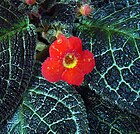 Episcia cupreata flower Episcia cupreata flower
|
You are receiving this because you added your name to the subscribers list of the WikiProject Tree of Life. If you no longer wish to receive the newsletter, please remove your name.
Sent by ZLEA via MediaWiki message delivery (talk) 18:59, 1 August 2019 (UTC)
Why do you delete every major edit I do?
Is pretty understandable if my edits were bandalism, I was only trying to expand stubs, thats what the page says, This article is a stub. You can help Misplaced Pages by expanding it. Honestly it feels like only extended users can do edits, while new users can not, even if you have valid sources.--PaleoNeolitic (talk) 02:46, 6 August 2019 (UTC)
What do you think of this and how can we get the page reviewed?
Atlantis536 (talk) 06:44, 20 August 2019 (UTC)
August 2019 Tree of Life Newsletter

- August 2019—Issue 005
- Tree of Life
- Welcome to the Tree of Life newsletter!
|
|
|
|
  Guest column by Thomas Shafee (Evolution and evolvability), Editor in Chief of WikiJournal of Science
Firstly, WikiJSci can be a complementary system for FA review (getting external review, input, and validity). When an Misplaced Pages article is nominated (via WP:JAN), journal editors go out to non-Wikipedian academics and researchers who have published on the subject on the last five years and invite them to give feedback comments (e.g. Peripatric speciation and Baryonyx). The resulting changes can then be integrated back into the Misplaced Pages article.
Getting more editors involved in Misplaced Pages is always a high priority. WikiJSci can also be a way to encourage new people to contribute articles (especially on missing/stub/start topics). An example of an article that was written from scratch by a group of non-Wikipedians is Teladorsagia circumcincta. This not only resulted in a new Misplaced Pages page on an underdeveloped topic, but introduced the idea of Wikimedia contribution to a group of people who had previously never considered it.
The journal can be a way to get multimedia content reviewed or encourage contribution. The same approach could be easily adapted to sounds (e.g. frog mating calls) or videos (e.g. starfish feet motion). It also allows for tracking of those images in new articles via Altmetric (this example has >200, which is bananas). There aren't any biology examples in WikiJSci yet, but the sister medical journal has published a few summary diagrams, photography, and image galleries. Examples include this gallery by Blausen Medical or the diagram of cell disassembly during apoptosis.
For those interested in other Wikimedia sister projects, there's also broad scope for interactions with the WikiJournals. Perhaps peer reviewed teaching resources could be useful to sit alongside sets of Misplaced Pages articles and be integrated into Wikiversity courses (like this or this)? Can sections of Wikidata & Wikispecies be peer reviewed? What are the potential avenues for integration with WikiCite, WikiFactMine, Scholia, etc.? Currently, WikiJSci is aiming to be very flexible and try out different formats so long as they can be externally peer reviewed. For more info, see the 2019-06-30 Signpost article and the current sister project proposal. |
|
1) Enwebb: You're very prolific with DYKs, with over 2,000 nominations credited (in fact, I'll highlight which DYK nominations this month were yours below). What made you become so involved in this part of Misplaced Pages? Why should Tree of Life editors nominate articles for DYK?
2) Enwebb: I noticed that your DYK nominations reflect a diverse array of flora and fauna, from trees, marine invertebrates, birds, fishes, and mammals. How do you decide what to work on?
3) Enwebb: Which of your Misplaced Pages accomplishments are you most proud of?
4) Enwebb: What motivates you to keep contributing? What's your 10,000 ft view (pardon the non-SI) of the community and Tree of Life?
6) Enwebb: How did you first become interested in natural history?
|
 Weebill Weebill
 Nanhaipotamon macau Nanhaipotamon macau
 P. lutzii (yeast phase) P. lutzii (yeast phase)
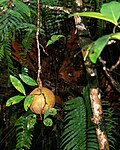 Cannonball mangrove Cannonball mangrove
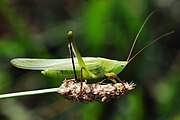 Ruspolia nitidula male Ruspolia nitidula male
 Female kob and calf Female kob and calf
|
You are receiving this because you added your name to the subscribers list of the WikiProject Tree of Life. If you no longer wish to receive the newsletter, please remove your name.
Sent by ZLEA via MediaWiki message delivery (talk) at 15:43, 1 September 2019 (UTC)
September 2019 Tree of Life Newsletter

- September 2019—Issue 006
- Tree of Life
- Welcome to the Tree of Life newsletter!
|
|
|
|
|
5
10
15
20
'02
'04
'06
'08
'10
'12
'14
'16
'18
This month saw a vanishingly rare occurrence for the Tree of Life: a new WikiProject joined the fold. WikiProject Diptera, however, is also unusual in being a classroom project. Whether or not this project will stay active once the semester ends remains to be seen. It does not bode well, however, that WP:WikiProject Vespidae—a creation from the same instructor at St. Louis University—faded to obscurity shortly after the fall semester concluded in 2014. WikiProject Vespidae is defunct and now redirects to the Hymenoptera task force of WikiProject Insects. Since 2014, the Tree of Life has seen a string of years where one or zero projects or task forces were created. The only projects and task forces created since then are WikiProject Animal anatomy (2014), Hymenoptera task force (2016), Bats task force (2017), WikiProject Hypericaceae (2018), and now WikiProject Diptera (2019). The year 2006 saw the greatest creation of WikiProjects and task forces, with fourteen still active and the remaining six as "semiactive", "inactive", or "defunct". |
 Enischnomyia fossil in Dominican amber Enischnomyia fossil in Dominican amber
 Lebombo wattle in the sand forest Lebombo wattle in the sand forest
 Betula leopoldae leaf fossil Betula leopoldae leaf fossil
 Pholiota squarrosoides Pholiota squarrosoides
 Lady Burton's rope squirrel Lady Burton's rope squirrel
 A child picks chili peppers in an Indonesian home garden. A child picks chili peppers in an Indonesian home garden.
|
You are receiving this because you added your name to the subscribers list of the WikiProject Tree of Life. If you no longer wish to receive the newsletter, please remove your name.
Sent by ZLEA via MediaWiki message delivery (talk) at 22:26, 1 October 2019 (UTC)
October 2019 Tree of Life Newsletter

- October 2019—Issue 007
- Tree of Life
- Welcome to the Tree of Life newsletter!
|
|
|
|
|
|
By request from another editor, this month I wrote an overview of ways that content is featured on Misplaced Pages. Below I have outlined some of the processes for getting content featured: Did You Know (DYK)What is it: A way for articles to appear on the main page of Misplaced Pages. A short hook in the format of "Did you know...that ___" presents unusual and interesting facts to the reader, hopefully making the reader want to click through to the article How it works: The DYK process has fairly low barriers for participation. The eligibility criteria are few and relatively easy to meet. Some important guidelines:
The process for creating the nomination is somewhat tedious. Instructions can be found here (official instructions) and here ("quick and nice" guide to DYK). Experience is the best teacher here, so don't be afraid to try and fail a few times. The last few DYK nominations I've done, however, have been with the help of SD0001's DYK-helper script, which makes the process a bit more streamlined (you create the template from a popup box on the article; created template is automatically transcluded to nominations page and article talk page) Once your nomination is created and transcluded, it will need to be reviewed. The reviewer will check that the article meets the eligibility criteria, that the hook is short enough, cited, and interesting, and that other requirements are met, such as for images. If you've been credited with more than 5 DYKs, the reviewer will also check that you've reviewed someone else's nomination for each article that you nominate. This is called QPQ (quid pro quo). You can check how many credited DYKs you've had here to see if QPQ is required for you to nominate an article for DYK. Good Article (GA)What it is: A peer review process to determine that an article meets a set of criteria. This adds a How it works: You follow the instructions to nominate an article, placing a template on its talk page. Anyone can nominate an article—you don't have to be a major contributor, though it is considered polite to inform the major contributors that you are nominating the article. The article is added to a queue to await a review. In the ToL, it seems that reviews happen pretty quickly, thanks to our dedicated members. Once the review begins, the reviewer will offer suggestions to help the article meet the 6 GA criteria. Upon addressing all concerns, the reviewer will pass the article, and voilà! Good Article! Advice to a first-time nominator: Look at other Good Articles in related areas before nominating. If you're unsure about nominating, consider posting to the talk page of your project to see what other editors think. You can also have a more experienced editor co-nominate the article with you. Featured Article (FA)What it is: An exhaustive peer review to determine that an articles meets the criteria. This adds a How it works: You follow the instructions to nominate an article, placing a template on its talk page. Nominated articles are usually GAs already. Uninvolved editors can nominate, though the article's regular editors should be consulted first. Several editors will come by offering feedback, eventually supporting or opposing promotion to FA. A coordinator will determine if there is consensus to promote the article to FA. For an editor's first FA, spot checks to verify that the sources support the text are conducted. Advice to a first-time nominator: The Featured Article Candidate (FAC) process is a bit intimidating, but several steps can make your first one easier (speaking as someone who has exactly one). If you also did the GA nomination of the article, you can ask the reviewer for "extra" feedback beyond the GA criteria. You can also formally request a peer review and/or a copy edit from the Guild of Copy Editors to check for content and mechanics. First-time nominators are encouraged to seek the help of a mentor for a higher likelihood of passing their first FAC. Good and Featured Topics (GT and FT)What it is: It took me a while to realize we even had GT and FT on Misplaced Pages, as they are not very common relative to GA and FA. Both GT and FT are collections of related articles of high quality (all articles at GA or FA, all lists at Featured List). GT/FT have to be at least 3 articles with no obvious gaps in coverage of the topic, along with other criteria. For GT, all articles have to be GA quality and all lists must be FL. For FT, at least half the articles must be FA or FL, with the remaining articles at GA. How it works: Follow the nomination procedures for creating a new topic or adding an article to an existing topic. Other editors weigh in to support or oppose the proposal. Coordinators determine if there is consensus to promote to GT/FT. Advice to a first-time nominator: There are very few GT/FT in Tree of Life (5 GT and 11 FT). Most of the legwork appears to be improving a cohesive set of articles to GA/FA. |
 Female apple maggot Female apple maggot
|
You are receiving this because you added your name to the subscribers list of the WikiProject Tree of Life. If you no longer wish to receive the newsletter, please remove your name.
Delivered by MediaWiki message delivery (talk) at 03:34, 3 November 2019 (UTC) on behalf of DannyS712 (talk)
Notice of edit warring noticeboard discussion
![]() Hello. This message is being sent to inform you that there is currently a discussion involving you at Misplaced Pages:Administrators' noticeboard/Edit warring regarding a possible violation of Misplaced Pages's policy on edit warring. Thank you. — Preceding unsigned comment added by 85.241.166.123 (talk) 13:19, 13 November 2019 (UTC)
Hello. This message is being sent to inform you that there is currently a discussion involving you at Misplaced Pages:Administrators' noticeboard/Edit warring regarding a possible violation of Misplaced Pages's policy on edit warring. Thank you. — Preceding unsigned comment added by 85.241.166.123 (talk) 13:19, 13 November 2019 (UTC)
- A link to the report is at Misplaced Pages:Administrators' noticeboard/Edit warring#User:Lusotitan reported by User:85.241.166.123 (Result: ). Thank you, EdJohnston (talk) 13:44, 13 November 2019 (UTC)
ArbCom 2019 election voter message
| Hello! Voting in the 2019 Arbitration Committee elections is now open until 23:59 on Monday, 2 December 2019. All eligible users are allowed to vote. Users with alternate accounts may only vote once.
The Arbitration Committee is the panel of editors responsible for conducting the Misplaced Pages arbitration process. It has the authority to impose binding solutions to disputes between editors, primarily for serious conduct disputes the community has been unable to resolve. This includes the authority to impose site bans, topic bans, editing restrictions, and other measures needed to maintain our editing environment. The arbitration policy describes the Committee's roles and responsibilities in greater detail. If you wish to participate in the 2019 election, please review the candidates and submit your choices on the voting page. If you no longer wish to receive these messages, you may add |
November 2019 Tree of Life Newsletter

- November 2019—Issue 008
- Tree of Life
- Welcome to the Tree of Life newsletter!
|
|
| News at a Glance |
|
| Class is in Session in the Tree of Life |
|
In an interesting turn of events, this month's guest column is by my alter-ego, Elysia (Wiki Ed): *Puts on Wiki Education hat* Hi everyone, I'm Elysia and I work for Wiki Education. You may know me as Enwebb. I got a request last month to let you know how Wiki Education is intersecting with the Tree of Life subprojects. As one of Wiki Education's major goals is to improve topics related to the sciences, leading to our Communicating Science initiative, we end up supporting quite a few in the biological sciences. Here are the TOL-related courses active this term:
What is the impact of student editors in Tree of Life? 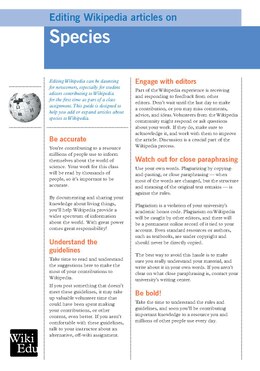 Altogether, these 16 courses have 347 student participants. As the end of the semester hasn't come yet, these numbers are still growing, but these students have:
Some of our best student work this semester (of any kind, not just biodiversity) has come from Agelaia's Behavioural Ecology course—you may remember this as the course that created WikiProject Diptera. The students have several Good Article nominations, including Dryomyza anilis, Anastrepha ludens, Aedes taeniorhynchus, Drosophila silvestris, Drosophila subobscura, and Ceratitis capitata. And while long-term participation from students is low, there's always the chance that we'll discover a Wikipedian. I had never edited before my Misplaced Pages assignment in 2017 and I'm still here nearly 20,000 edits later! After I poked around in the beginning of the semester, I had the realization that not many people write Misplaced Pages, and very few of those have a special interest in bats. If I didn't stick around to write the content, there was no guarantee that it would ever get done. Why are species articles suitable for students? Writing about taxonomic groups is a great fit for students, as it keeps them away from areas where new editors traditionally struggle. The notability policy is generous towards taxa, and there is little danger of a student's work getting removed for lack of notability; this is to be expected when students write biographies. Students may struggle with encyclopedic tone for biographies and stray towards promotional writing, but this is much less common when writing about a shrew or algae! Additionally, we're never going to run out of species to write about. Students have a bounty of stubs and redlinks to pick from. Creating a new article or expanding an existing one also takes a fairly predictable structure, with plenty of articles that students can model after. Don't students just create messes for volunteers to clean up? Our sincere hope is that, no, they don't, and we take several steps to try to minimize the burden on volunteer labor. With automatic plagiarism detection, alerts when students edit a Good or Featured Article, and notifications when students edit an article subject to discretionary sanctions, we try to stay ahead of problems as much as possible. We also review all student work at the end of each term. Ian, Shalor, and I are always happy to receive pings alerting us to student issues that need to be addressed. |
| November DYKs |
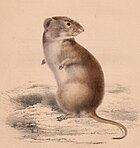 Brants's whistling rat Brants's whistling rat
 Female black-capped tanager Female black-capped tanager
|
You are receiving this because you added your name to the subscribers list of the WikiProject Tree of Life. If you no longer wish to receive the newsletter, please remove your name.
December 2019 Tree of Life Newsletter

- December 2019—Issue 009
- Tree of Life
- Welcome to the Tree of Life newsletter!
|
|
|
|
| News at a Glance |
|
| Editor Spotlight: Plantdrew |
|
We're joined this month by long-time editor Plantdrew, who's currently engaged in streamlining the taxonomic structure of Misplaced Pages articles via the automated taxobox system. How did you become a Wikipedian? What are your particular interests (besides the obvious of "plants")?
What projects are keeping you busy around the 'pedia at present?
What's your favorite plant?
What's your background like? How did you come to have a special interest in biology?
What's something that would surprised TOL editors about your life off-wiki?
Anything else you'd like us to know?
|
| December DYKs |
 Member of genus Chrysomya Member of genus Chrysomya
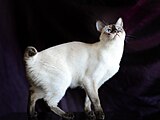 Mekong Bobtail Mekong Bobtail
|
You are receiving this because you added your name to the subscribers list of the WikiProject Tree of Life. If you no longer wish to receive the newsletter, please remove your name.
Speedy deletion nomination of Template:Ornithomimosauria

A tag has been placed on Template:Ornithomimosauria requesting that it be speedily deleted from Misplaced Pages. This has been done under section T3 of the criteria for speedy deletion because it is an unused duplicate of another template, or a hard-coded instance of another template. After seven days, if it is still unused and the speedy deletion tag has not been removed, the template will be deleted.
If the template is not actually the same as the other template noted, please consider putting a note on the template's page explaining how this one is different so as to avoid any future mistakes.
If you think this page should not be deleted for this reason, you may contest the nomination by visiting the page and clicking the button labelled "Contest this speedy deletion". This will give you the opportunity to explain why you believe the page should not be deleted. However, be aware that once a page is tagged for speedy deletion, it may be deleted without delay. Please do not remove the speedy deletion tag from the page yourself, but do not hesitate to add information in line with Misplaced Pages's policies and guidelines. If the page is deleted, and you wish to retrieve the deleted material for future reference or improvement, then please contact the deleting administrator, or if you have already done so, you can place a request here. Pkbwcgs (talk) 16:08, 11 January 2020 (UTC)
January 2020 Tree of Life Newsletter

- January 2020—Issue 010
- Tree of Life
- Welcome to the Tree of Life newsletter!
|
|
|
|
| News at a Glance |
|
| Vital Articles | ||||||||||||||||||||||||||||||||||||||||||||||||||||||||||||||||||||||||||||||||||||||||||||||||||
|
The vital articles project on English Misplaced Pages began in 2004 when an editor transferred a list from Meta-Wiki: List of articles every Misplaced Pages should have. The first incarnation of the list became what is now level 3. As of 2019, there are 5 levels of vital articles:
Each level is inclusive of all previous levels, meaning that the 1,000 Level 3 articles include those listed on Levels 2 and 1. Below is an overview of the distribution of vital articles, and the quality of the articles. While the ultimate goal of the vital articles project is to have Featured-class articles, I also considered Good Articles to be "complete" for the purposes of this list. Animals (1,148 designated out of projected 2,400)
Many articles have yet to be designated for Tree of Life taxonomic groups, with 1,942 outstanding articles to be added. Anyone can add vital articles to the list! Restructuring may be necessary, as the only viruses included as of yet are under the category "Health". The majority of vital articles needing improvement are level 5, but here are some outstanding articles from the other levels:
· Abiogenesis
· Sexual dimorphism |
| January DYKs |
 Fossil teeth of Alopias palatasi Fossil teeth of Alopias palatasi
 LuEsther T. Mertz Library LuEsther T. Mertz Library
 The Central Park mandarin duck The Central Park mandarin duck
 Christmas Island red crab Christmas Island red crab
 Salvador Dalí with his pet ocelot Babou Salvador Dalí with his pet ocelot Babou
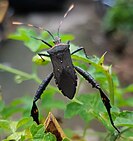 Passionvine bug Passionvine bug
 Tansy beetle Tansy beetle
 Winter bell Winter bell
 Doubleband surgeonfish Doubleband surgeonfish
|
You are receiving this because you added your name to the subscribers list of the WikiProject Tree of Life. If you no longer wish to receive the newsletter, please remove your name.
February 2020 Tree of Life Newsletter

- February 2020—Issue 011
- Tree of Life
- Welcome to the Tree of Life newsletter!
|
|
|
|
| News at a Glance |
|
| The spread of coronavirus across Misplaced Pages | ||||||||||||||||||||||||||||||||||||||||||||||||
|
With the outbreak of a novel coronavirus dominating news coverage, Misplaced Pages content related to the virus has seen much higher interest. Tree of Life content of particular interest to readers has included viruses, bats, pangolins, and masked palm civets. Viruses saw the most dramatic growth in readership: Coronavirus, which was the 105th most popular virus article in December 2019 with about 400 views per day, averaged over a quarter million views each day of January 2020. Total monthly viewership of the top-10 virus articles ballooned from about 1.5 million to nearly 20 million.
 From October 2019 – December 2019, the top ten most popular bat articles fluctuated among 16 different articles, with the December viewership of those 10 articles at 209,280. For January 2020, three articles broke into the top-10 that were not among the 16 articles of the prior three months: Bat as food, Horseshoe bat, and Bat-borne virus. Viewership of the top-10 bat articles spiked nearly 300% to 617,067 in January. While bats have been implicated as a possible natural reservoir of SARS-CoV-2, an intermediate host may be the bridge between bats and humans. Pangolins have been hypothesized as the intermediate host for the virus, causing a large spike in typical page views of 2-3k each day up to more than 60k in a day. Masked palm civets, the intermediate host of SARS, saw a modest yet noticeable spike in page views as well, from 100 to 300 views per day to as many as 5k views per day. With an increase in viewers came an increase in editors. In an interview, longtime virus editor Awkwafaba identified the influx of editors as the biggest challenge in editing content related to the coronavirus. They noted that these newcomers include "novices who make honest mistakes and get tossed about a bit in the mad activity" as well as "experienced editors who know nothing about viruses and are good researchers, yet aren't familiar with the policies of WP:ToL or WP:Viruses." Disruption also increased, with extended confirmed protection (also known as the 30/500 rule, which prevents editors with fewer than 30 days tenure and 500 edits from making edits and is typically used on a very small subset of Misplaced Pages articles) temporarily applied to Coronavirus and still active on Template:2019–20 coronavirus outbreak data. New editors apparently seeking to correct misinformation continuously edited the article Bat as food to remove content related to China: Videos of Chinese people eating bat soup were misrepresented to be current or filmed in China, when at least one such video was several years old and filmed in Palau. However, reliable sources confirm that bats are eaten in China, especially Southern China, so these well-meaning edits were mostly removed. Another level of complexity was added by the fluctuating terminology of the virus. Over a dozen moves and merges were requested within WikiProject Viruses. To give you an idea of the musical chairs happening with article titles, here are the move histories of two articles: Severe acute respiratory syndrome coronavirus 2
Awkwafaba noted that "the main authorities, WHO and ICTV, don't really have a process for speedily naming a virus or disease." Additionally, they have different criteria for naming. They said, "I remember in a move discussion from the article then called Wuhan coronavirus that a virus name cannot have a geographical location in it, but this is a WHO disease naming guideline, and not an ICTV virus naming rule. ICTV may have renamed Four Corners virus to Sin Nombre orthohantavirus but there are still plenty of official virus species names that don't abide by WHO guidelines." |
| February DYKs |
 Thistle broomrape Thistle broomrape
 Painting of the Shelton Oak Painting of the Shelton Oak
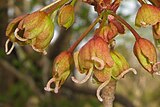 Female A. diabolicum flowers with curled stigmas Female A. diabolicum flowers with curled stigmas
|
You are receiving this because you added your name to the subscribers list of the WikiProject Tree of Life. If you no longer wish to receive the newsletter, please remove your name.
March 2020 Tree of Life Newsletter

- March 2020—Issue 012
- Tree of Life
- Welcome to the Tree of Life newsletter!
|
|
|
|
| News at a glance |
|
| A new WikiProject responding to the pandemic | ||
|
The newest Tree of Life WikiProject is about a taxon that is dominating the headlines, Severe acute respiratory syndrome coronavirus 2, and its many effects. We interviewed Another Believer, the founder of WikiProject COVID-19. This interview has been edited for length. Find the full interview here. Number of participants of WikiProject Covid-19
Thank you to Another Believer for your time, both in this interview and in this project. Interested readers can join WikiProject COVID-19. And please stay safe and healthy out there. --Awkwafaba |
| March DYKs |
|
You are receiving this because you added your name to the subscribers list of the WikiProject Tree of Life. If you no longer wish to receive the newsletter, please remove your name.
April 2020 Tree of Life Newsletter

- April 2020—Issue 013
- Tree of Life
- Welcome to the Tree of Life newsletter!
|
|
|
|
| News at a glance |
|
| Tree of Life's growing featured content | ||||||||||||||||||||||||||||||||||||||||||||||||||||||||||||||||||||||||||||||||||||||||||||||||||||||||||||||||||||||||||||||||||||||||||||||||||||||||||||||||||||||||||||||||||||||||||||||||||||||||||||||||||||||||||||||||||||||||||||||||||||||||||||||||||||||||||||||||||||||||||||||||||||||||||||||||||||||||||||||||||||||||||||||||||||||||||||||||||||||||||||||||||||||||||||||||||||||||||||||||||||||||||||||||||||||||||||||||||||||||||||||||||
|
Inspired by a March 2020 post at WikiProject Medicine detailing the growth of Featured Articles over time, we decided to reproduce that table here, adding a second table showing the growth of Good Articles. Tree of Life articles are placed in the "Biology" category for FAs, which has seen a growth of 381% since 2008. Only two other subjects had a greater growth than Biology: Business, economics, and finance; and Warfare. Percentage Growth in FA Categories, 2008–2019, Legend: Considerably above average, Above average, Average Below average , Considerably below average, Poor
*subset of natural sciences Unsurprisingly, the number of GAs has increased more rapidly than the number of FAs. Organisms, which is a subcategory of Natural sciences, has seen a GA growth of 755% since 2008, besting the Natural sciences overall growth of 530%. While Warfare had far and away the most significant growth of GAs, it's a clear outlier relative to other categories. |
| April DYKs |
 Jenny Jenny
 White-throated round-eared bat White-throated round-eared bat
 Formica fusca ants tending mealybugs Formica fusca ants tending mealybugs
|
You are receiving this because you added your name to the subscribers list of the WikiProject Tree of Life. If you no longer wish to receive the newsletter, please remove your name.
MediaWiki message delivery (talk) 02:40, 5 May 2020 (UTC)
May 2020 Tree of Life Newsletter

- May 2020—Issue 014
- Tree of Life
- Welcome to the Tree of Life newsletter!
|
|
| News at a glance |
|
| Interview with Jts1882 | |||||||||||||||||||||||||||||||||||||||||||||||||||||||||||||||||||||||||||||||||||||||||||||||||||||||||||||||||||||||||||||||||||||||||||||||||||||||||||||||||||||||||||||||||||||||||||||
|
This month we're joined by Jts1882, who is active in depicting evolutionary relationship of taxa via cladograms. Part of this includes responding to cladogram requests, where interested editors can have cladograms made without using the templates themselves. How did you come to be interested in systematics? Are you interested in systematics broadly, or is there a particular group you're most fond of? As long as I can remember I’ve been interested in nature, starting with the animals and plants in the garden, school grounds, and local wood, and then more general wildlife worldwide. An interest in how things are classified grew from this. I like things to be organised and understanding the relationships between things and systems (not just living things) is a big part of that. Biology was always my favourite subject in school and took up a disproportionate part of my time. My interest in systematics is broad as I’d like to comprehend the whole tree of life, but the cat family is my favourite group. What's the background behind cladogram requests? I see that it isn't a very old part of the Tree of Life Well I can’t take any credit for the cladogram requests page, although I help out there sometimes. It was created by IJReid and there are several people who have helped there more than me. I think the motivation is that creating cladograms requires a knowledge of the templates that is daunting for many editors. It was one way of helping people who want to focus on content creation. My main contribution to the cladograms is converting the {{clade}} template to use a Lua module. The template code was extremely difficult to follow and had to be repetitive (I can only admire the efforts of those who got the thing to work in the first place). The conversion to Lua made it more efficient, allowed larger and deeper cladograms, plus facilitating the introduction of new features. The cladogram request page was recently the venue for discussion on making time calibrated cladograms, which is now possible, if not particularly user friendly. What advice do you have for an editor who wants to learn how to make cladograms? The same advice I would give to someone facing any computer problem, just try it out. Start by taking existing code for a cladogram and make changes yourself. The main advice would be to format it properly so indents match the brackets vertically. Of course, not everyone wants to learn and if someone prefers to focus on article content there is the cladogram request page. Examples of cladograms Jts1882 has created, showing different proposed clades for Neoaves
Do you have any personal projects or goals you're working towards on Misplaced Pages? As I said I like organisation and systems. So I find efforts like the automated taxobox system and {{taxonbar}} appealing. I would like to see more reuse of the major phylogenetic trees on Misplaced Pages with more use of consensus trees on the higher taxa. Too often they get edited based on one recent report and/or without proper citation. Animals and bilateria are examples where this is a problem. Towards this I have been working on a system of phylogeny templates that can be reused flexibly. The {{Clade transclude}} template allows selective transclusion, so the phylogenetic trees on one page can be reused with modifications, i.e. can be pruned and grafted, used with or without images, with or without collapsible elements, etc. I have an example for the Angiosperm Phylogeny Group classification (see {{Phylogeny/APG IV}}) and one for squamates that also includes collapsible elements (see {{Phylogeny/Squamata}}). A second project is to have a modular reference system for taxonomic resources. I have made some progress along this lines with the {{BioRef}} template. This started off simply as a way of hardlinking to Catalog of Fishes pages and I’ve gradually expanded it to cover other groups (e..g. FishBase, AmphibiaWeb and Amphibian Species of the World, Reptile Database, the Mammalian Diversity Database). The modular nature is still rudimentary and needs a rewrite before it is ready for wider use. What would surprise your fellow editors to learn about your life off-Misplaced Pages? I don’t think there is anything particularly surprising or interesting about my life. I’ve had an academic career as a research scientist but I don't think anyone could guess the area from my Misplaced Pages edits. I prefer to work on areas where I am learning at the same time. This why I spend more time with neglected topics (e.g. mosses at the moment). I start reading and then find that I’m not getting the information I want. Anything else you'd like us to know? My interest in the classification of things goes beyond biology. I am fascinated by mediaeval attempts to classify knowledge, such as Bacon in his The Advancement of Learning and Diderot and d’Alembert in their Encyclopédie. They were trying to come up with a universal scheme of knowledge just as the printing press was allowing greater dissemination of knowledge. With the internet we are seeing a new revolution in knowledge dissemination. Just look at how we could read research papers on the COVID virus within weeks of its discovery. With an open internet, everyone has access, not just those with the luxury of books at home or good libraries. Sites like the Biodiversity Heritage Library allow you to read old scientific works without having to visit dusty university library stack rooms, while the taxonomic and checklist databases provide instant information on millions of living species. In principle, the whole world can now find out about anything, even if Douglas Adams warned we might be disinclined to do so. This is why I like Misplaced Pages, with all its warts, it’s a means of organising the knowledge on the internet. In just two decades it’s become a first stop for knowledge and hopefully a gateway to more specialised sources. Perhaps developing this latter aspect, beyond providing good sources for what we say, is the next challenge for Misplaced Pages. |
| May DYKs |
 Slender Scotch burnet moth on a flower Slender Scotch burnet moth on a flower
 Northern plains gray langur Northern plains gray langur
 Male vermilion flycatcher Male vermilion flycatcher
 Canada lynx Canada lynx
 Meerkats Meerkats
 Hilarimorphites burmanica Hilarimorphites burmanica
 Sun bear Sun bear
|
You are receiving this because you added your name to the subscribers list of the WikiProject Tree of Life. If you no longer wish to receive the newsletter, please remove your name.
Enwebb (talk) 19:40, 3 June 2020 (UTC)
"for heaven's sake"
Can't you be a bit nicer, I didn't enjoy it. There is absolutely no consensus that E. kuukpikensis is a valid subspecies of Edmontosaurus (I didn't see any paper doing this, in fact); rather, it is referred to E. sp. in the latest study. Thus my revert. --Jens Lallensack (talk) 05:32, 7 July 2020 (UTC)
- It was talked about on the talk page and the rename was considered the best choice of compromise. In light of the rename it must as such be linked at Edmontosaurus. Perhaps it can be labelled as dubious in the taxobox. Lusotitan (Talk | Contributions) 05:45, 7 July 2020 (UTC)
- The combination Edmontosaurus kuukpikensis does not exist at all (no hits in a google scholar search). This is not a compromise, this is inventing a new combination, and is absolutely against WP:OR. Please revert again to the previous version of the article. --Jens Lallensack (talk) 05:52, 7 July 2020 (UTC)
- Ugrunaaluk is not considered a valid taxon distinct from Edmontosaurus in the modern literature. It is unacceptable for it to be left to exist in its original state. Lusotitan (Talk | Contributions) 07:12, 7 July 2020 (UTC)
- I never suggested to keep that article. Ugrunaaluk should redirect to Edmontosaurus, and Edmontosaurus kuukpikensis, as a made-up name, has to be deleted altogether (no redirect, per WP:OR). Content needs to be merged with Edmontosaurus. --Jens Lallensack (talk) 07:17, 7 July 2020 (UTC)
- E. kuukpikensis is probably useful to have as a redirect seeing as the name is often used online. Folks might try searching it. Lusotitan (Talk | Contributions) 13:25, 7 July 2020 (UTC)
- Agreed, should be fine to keep it as a redirect. --Jens Lallensack (talk) 14:07, 7 July 2020 (UTC)
- You will need to discuss this at either the page of the WikiProject before doing such. Lusotitan (Talk | Contributions) 19:11, 7 July 2020 (UTC)
- FunkMonk already filed a merge proposal. My personal concern was with the Edmontosaurus article, which is now resolved as well. --Jens Lallensack (talk) 19:18, 7 July 2020 (UTC)
- You will need to discuss this at either the page of the WikiProject before doing such. Lusotitan (Talk | Contributions) 19:11, 7 July 2020 (UTC)
- Agreed, should be fine to keep it as a redirect. --Jens Lallensack (talk) 14:07, 7 July 2020 (UTC)
- E. kuukpikensis is probably useful to have as a redirect seeing as the name is often used online. Folks might try searching it. Lusotitan (Talk | Contributions) 13:25, 7 July 2020 (UTC)
- I never suggested to keep that article. Ugrunaaluk should redirect to Edmontosaurus, and Edmontosaurus kuukpikensis, as a made-up name, has to be deleted altogether (no redirect, per WP:OR). Content needs to be merged with Edmontosaurus. --Jens Lallensack (talk) 07:17, 7 July 2020 (UTC)
- Ugrunaaluk is not considered a valid taxon distinct from Edmontosaurus in the modern literature. It is unacceptable for it to be left to exist in its original state. Lusotitan (Talk | Contributions) 07:12, 7 July 2020 (UTC)
- The combination Edmontosaurus kuukpikensis does not exist at all (no hits in a google scholar search). This is not a compromise, this is inventing a new combination, and is absolutely against WP:OR. Please revert again to the previous version of the article. --Jens Lallensack (talk) 05:52, 7 July 2020 (UTC)
June/July 2020 Tree of Life Newsletter

- June and July 2020—Issue 015
- Tree of Life
- Welcome to the Tree of Life newsletter!
|
|
| News at a glance |
|
| Categorizing life with DexDor |
|
DexDor is a WikiGnome with a particular interest in article categorization, including how organisms are categorized.
|
| June DYKs |
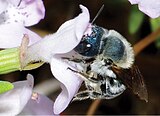 Blue calamintha bee Blue calamintha bee
 Culture of S. aureus Culture of S. aureus
 Ambay pumpwood Ambay pumpwood
 Heuglin's gazelle Heuglin's gazelle
 Gold-striped frog Gold-striped frog
|
| July DYKs |
 Amazon parrot Amazon parrot
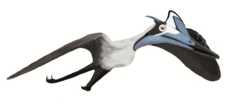 Life reconstruction of Pterodactylus antiquus Life reconstruction of Pterodactylus antiquus
|
You are receiving this because you added your name to the subscribers list of the WikiProject Tree of Life. If you no longer wish to receive the newsletter, please remove your name.
Delivered on behalf of Enwebb (talk) 16:33, 1 August 2020 (UTC)
August 2020 Tree of Life Newsletter

- September 2021—Issue 016
- Tree of Life
- Welcome to the Tree of Life newsletter!
|
|
|
|
| Hoax taxon sniffed out after nearly fifteen years |
|
Cross posted from the Signpost 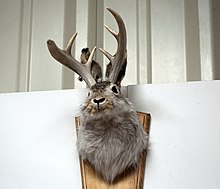 On August 7, WikiProject Palaeontology member Rextron discovered a suspicious taxon article, Mustelodon, which was created in November 2005. The article lacked references and the subsequent discussion on WikiProject Palaeontology found that the alleged type locality (where the fossil was first discovered) of Lago Nandarajo "near the northern border of Panama" was nonexistent. In fact, Panama does not even really have a northern border, as it is bounded along the north by the Caribbean Sea. No other publications or databases mentioned Mustelodon, save a fleeting mention in a 2019 book that presumably followed Misplaced Pages, Felines of the World. The article also appeared in four other languages, Catalan, Spanish, Dutch, and Serbian. In Serbian Misplaced Pages, a note at the bottom of the page warned: "It is important to note here that there is no data on this genus in the official scientific literature, and all attached data on the genus Mustelodon on this page are taken from the English Misplaced Pages and are the only known data on this genus of mammals, so the validity of this genus is questionable." Editors took action to alert our counterparts on other projects, and these versions were removed also. As the editor who reached out to Spanish and Catalan Misplaced Pages, it was somewhat challenging to navigate these mostly foreign languages (I have a limited grasp of Spanish). I doubted that the article had very many watchers, so I knew I had to find some WikiProjects where I could post a machine translation advising of the hoax, and asking that users follow local protocols to remove the article. I was surprised to find, however, that Catalan Misplaced Pages does not tag articles for WikiProjects on talk pages, meaning I had to fumble around to find what I needed (turns out that WikiProjects are Viquiprojectes in Catalan!) Mustelodon remains on Wikidata, where its "instance of" property was swapped from "taxon" to "fictional taxon". How did this article have such a long lifespan? Early intervention is critical for removing hoaxes. A 2016 report found that a hoax article that survives its first day has an 18% chance of lasting a year. Additionally, hoax articles tend to have longer lifespans if they are in inconspicuous parts of Misplaced Pages, where they do not receive many views. Mustelodon was only viewed a couple times a day, on average. Mustelodon survived a brush with death three years into its lifespan. The article was proposed for deletion in September 2008, with a deletion rationale of "No references given; cannot find any evidence in peer-reviewed journals that this alleged genus actually exists". Unfortunately, the proposed deletion was contested and the template removed, though the declining editor did not give a rationale. Upon its rediscovery in August 2020, Mustelodon was tagged for speedy deletion under CSD G3 as a "blatant hoax". This was challenged, and an Articles for Deletion discussion followed. On 12 August, the AfD was closed as a SNOW delete. WikiProject Palaeontology members ensured that any trace of it was scrubbed from legitimate articles. The fictional mammal was finally, truly extinct. At the ripe old age of 14 years, 9 months, this is the longest-lived documented hoax on Misplaced Pages, topping the previous documented record of 14 years, 5 months, set by The Gates of Saturn, a fictitious television show, which was incidentally also discovered in August 2020. How do we discover other hoax taxa? Could we use Wikidata to discover taxa are not linked to databases like ITIS, Fossilworks, and others?
|
| Spotlight with Mattximus |
 This month's spotlight is with Mattximus, author of two Featured Articles and 29 Featured Lists at current count.
I think I have a compulsion to make lists, it doesn't show up in my real life, but online I secretly get a lot of satisfaction making orderly lists and tables. It's a bit of a secret of mine, because it doesn't manifest in any other part of my life. My background is in biology, so this was a natural (haha) fit.
This experiment was just to see if I could get any random article to FA status, so I picked the very first alphabetical animal species according to the taxonomy and made that attempt. Technically, there isn't enough information for a species page so I just merged the species into a genus and went from there. It was a fun exercise, but doing it alone is not the most fun so it's probably on pause for the foreseeable future. Note: Aporhynchus is the first alphabetical taxon as follows: Animalia, Acanthocephala, Archiacanthocephala, Apororhynchida, Apororhynchidae, Apororhynchus
I would recommend getting a good article nominated, then a featured list up before tackling the FA. Lists are a bit more forgiving but give you a taste of what standards to expect from FA. The most time consuming thing is proper citations so make sure that is in order before starting either.
My personality in real life does not match my wikipedia persona. I'm not a very organized, or orderly in real life, but the wikipedia pages I brought to FL or FA are all very organized. Maybe it's my outlet for a more free-flowing life as a scientist/teacher.
The fact that wikipedia exists free of profit motive and free for everyone really is something special and I encourage everyone to donate a few dollars to the cause. |
| August DYKs |
 Woolly thistle Woolly thistle
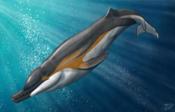 Life reconstruction of Ankylorhiza tiedemani Life reconstruction of Ankylorhiza tiedemani
 Female cicada laying eggs Female cicada laying eggs
 Acampe rigida Acampe rigida
|
You are receiving this because you added your name to the subscribers list of the WikiProject Tree of Life. If you no longer wish to receive the newsletter, please remove your name.
Delivered on behalf of Enwebb (talk) 17:10, 2 September 2020 (UTC)
ArbCom 2020 Elections voter message
| Hello! Voting in the 2020 Arbitration Committee elections is now open until 23:59 (UTC) on Monday, 7 December 2020. All eligible users are allowed to vote. Users with alternate accounts may only vote once.
The Arbitration Committee is the panel of editors responsible for conducting the Misplaced Pages arbitration process. It has the authority to impose binding solutions to disputes between editors, primarily for serious conduct disputes the community has been unable to resolve. This includes the authority to impose site bans, topic bans, editing restrictions, and other measures needed to maintain our editing environment. The arbitration policy describes the Committee's roles and responsibilities in greater detail. If you wish to participate in the 2020 election, please review the candidates and submit your choices on the voting page. If you no longer wish to receive these messages, you may add |
January 2021
![]() Hello, I'm William Harris. I noticed that you added or changed content in an article, Dire wolf, but you didn't provide a reliable source. It's been removed and archived in the page history for now, but if you'd like to include a citation and re-add it, please do so. You can have a look at the tutorial on citing sources. If you think I made a mistake, you can leave me a message on my talk page. Thank you. William Harris (talk) 03:17, 14 January 2021 (UTC)
Hello, I'm William Harris. I noticed that you added or changed content in an article, Dire wolf, but you didn't provide a reliable source. It's been removed and archived in the page history for now, but if you'd like to include a citation and re-add it, please do so. You can have a look at the tutorial on citing sources. If you think I made a mistake, you can leave me a message on my talk page. Thank you. William Harris (talk) 03:17, 14 January 2021 (UTC)
Your GA nomination of Adelolophus
Hi there, I'm pleased to inform you that I've begun reviewing the article Adelolophus you nominated for GA-status according to the criteria. ![]() This process may take up to 7 days. Feel free to contact me with any questions or comments you might have during this period. Message delivered by Legobot, on behalf of FunkMonk -- FunkMonk (talk) 15:41, 3 March 2021 (UTC)
This process may take up to 7 days. Feel free to contact me with any questions or comments you might have during this period. Message delivered by Legobot, on behalf of FunkMonk -- FunkMonk (talk) 15:41, 3 March 2021 (UTC)
Your GA nomination of Adelolophus
The article Adelolophus you nominated as a good article has passed ![]() ; see Talk:Adelolophus for comments about the article. Well done! If the article has not already appeared on the main page as a "Did you know" item, or as a bold link under "In the News" or in the "On This Day" prose section, you can nominate it within the next seven days to appear in DYK. Bolded names with dates listed at the bottom of the "On This Day" column do not affect DYK eligibility. Message delivered by Legobot, on behalf of FunkMonk -- FunkMonk (talk) 16:01, 29 March 2021 (UTC)
; see Talk:Adelolophus for comments about the article. Well done! If the article has not already appeared on the main page as a "Did you know" item, or as a bold link under "In the News" or in the "On This Day" prose section, you can nominate it within the next seven days to appear in DYK. Bolded names with dates listed at the bottom of the "On This Day" column do not affect DYK eligibility. Message delivered by Legobot, on behalf of FunkMonk -- FunkMonk (talk) 16:01, 29 March 2021 (UTC)
ArbCom 2021 Elections voter message
| Hello! Voting in the 2021 Arbitration Committee elections is now open until 23:59 (UTC) on Monday, 6 December 2021. All eligible users are allowed to vote. Users with alternate accounts may only vote once.
The Arbitration Committee is the panel of editors responsible for conducting the Misplaced Pages arbitration process. It has the authority to impose binding solutions to disputes between editors, primarily for serious conduct disputes the community has been unable to resolve. This includes the authority to impose site bans, topic bans, editing restrictions, and other measures needed to maintain our editing environment. The arbitration policy describes the Committee's roles and responsibilities in greater detail. If you wish to participate in the 2021 election, please review the candidates and submit your choices on the voting page. If you no longer wish to receive these messages, you may add |
Re: Stegouros
Do you have any preference as to which figures from the preprint you want uploaded? Like, do you want all of the extended data figures? Do you want the bonemap fig from the supplementary information pdf? Hemiauchenia (talk) 01:33, 3 December 2021 (UTC)
- Whoops, completely forgot to respond on that point, sorry. Both figures from the supplemental data could be potentially useful (in addition to the two others from the main paper I can personally upload through Researchgate). LittleLazyLass (Talk | Contributions) 01:36, 3 December 2021 (UTC)
- I've gone and uploaded all of them, even the researchgate ones, see https://commons.wikimedia.org/Category:Stegouros. Hemiauchenia (talk) 01:57, 3 December 2021 (UTC)
- Also some photos of Antarctopelta material in there that is probably worth incorporating into that article. Hemiauchenia (talk) 01:59, 3 December 2021 (UTC)
- I've gone and uploaded all of them, even the researchgate ones, see https://commons.wikimedia.org/Category:Stegouros. Hemiauchenia (talk) 01:57, 3 December 2021 (UTC)
DYK for Parankylosauria
On 15 December 2021, Did you know was updated with a fact from the article Parankylosauria, which you recently created, substantially expanded, or brought to good article status. The fact was ... that species in the dinosaur group Parankylosauria have tail weaponry termed a "macuahuitl", in reference to the Mesoamerican weapons of the same name? The nomination discussion and review may be seen at Template:Did you know nominations/Parankylosauria. You are welcome to check how many pageviews the nominated article or articles got while on the front page (here's how, Parankylosauria), and if they received a combined total of at least 416.7 views per hour (i.e., 5,000 views in 12 hours or 10,000 in 24), the hook may be added to the statistics page. Finally, if you know of an interesting fact from another recently created article, then please feel free to suggest it on the Did you know talk page.
— Amakuru (talk) 12:03, 15 December 2021 (UTC)
WikiProject Tree of Life Newsletter – 018

- February 2022—Issue 018
- Tree of Life
- Welcome to the Tree of Life newsletter!
|
|
|
|
| News at a glance |
|
| February DYKs |
 Dudleya cymosa subsp. pumila Dudleya cymosa subsp. pumila
 A Golden Retriever retrieving a shot game bird A Golden Retriever retrieving a shot game bird
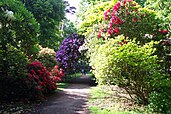 Rhododendrons at Sheringham Park Rhododendrons at Sheringham Park
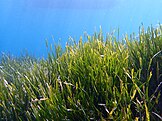 Seagrass in La Ciotat, France Seagrass in La Ciotat, France
|
You are receiving this because you added your name to the subscribers list of the WikiProject Tree of Life. If you no longer wish to receive the newsletter, please remove your name.
MediaWiki message delivery (talk) 14:45, 1 March 2022 (UTC)
WikiProject Tree of Life/Newsletter/019

- March 2022—Issue 019
- Tree of Life
- Welcome to the Tree of Life newsletter!
|
|
|
|
| News at a glance |
|
| March DYKs |
 Elysia timida Elysia timida
 Humbertium covidum Humbertium covidum
 Door Tree Door Tree
|
You are receiving this because you added your name to the subscribers list of the WikiProject Tree of Life. If you no longer wish to receive the newsletter, please remove your name.
MediaWiki message delivery (talk) 13:46, 1 April 2022 (UTC)
WikiProject Tree of Life Newsletter – 020

- April 2022—Issue 020
- Tree of Life
- Welcome to the Tree of Life newsletter!
|
|
| News at a glance |
|
| April DYKs |
 Whitehead's broadbill Whitehead's broadbill
 Anaea aidea Anaea aidea
|
You are receiving this because you added your name to the subscribers list of the WikiProject Tree of Life. If you no longer wish to receive the newsletter, please remove your name.
MediaWiki message delivery (talk) 14:57, 3 May 2022 (UTC)
See talk about Catalonia
The map with Europe is unnecessary and creates very obvious double standards generating a potential violation of WP:Neutrality. I have created a Talk explaining the reasons, feel free to read it or give your opinion about it there.
Thanks. Venezia Friulano (talk) 11:39, 6 May 2022 (UTC)
Mentioned in arbitration enforcement request
Hi there. I just wanted to give you a courtesy notification that I mentioned you by name in an arbitration enforcement request I've just lodged against Roxy the dog. The thread can be found here. I'd have used a template for this, but I don't think there is one. Sideswipe9th (talk) 18:38, 27 May 2022 (UTC)
Xing et al. (2022) Amurosaurus study
I noticed they added Lambeosaurus clavinitialis in their phylogenetic analysis. Do you think they did it because you added it to its species list on Misplaced Pages? If so, congratulations on changing science! 49.144.194.246 (talk) 02:06, 5 August 2022 (UTC)
ArbCom 2022 Elections voter message
Hello! Voting in the 2022 Arbitration Committee elections is now open until 23:59 (UTC) on Monday, 12 December 2022. All eligible users are allowed to vote. Users with alternate accounts may only vote once.
The Arbitration Committee is the panel of editors responsible for conducting the Misplaced Pages arbitration process. It has the authority to impose binding solutions to disputes between editors, primarily for serious conduct disputes the community has been unable to resolve. This includes the authority to impose site bans, topic bans, editing restrictions, and other measures needed to maintain our editing environment. The arbitration policy describes the Committee's roles and responsibilities in greater detail.
If you wish to participate in the 2022 election, please review the candidates and submit your choices on the voting page. If you no longer wish to receive these messages, you may add {{NoACEMM}} to your user talk page. MediaWiki message delivery (talk) 01:27, 29 November 2022 (UTC)
Happy Holidays

|
Happy Holidays | |
| Hello, I wish you the very best during the holidays. And I hope you have a very happy 2023! Bruxton (talk) 01:55, 26 December 2022 (UTC) |
Moore et al. 2023 M.sinocanadorum paper
Hey, it would seem like you have a copy of the new M.sinocanadorum paper? If you do, is it possible to have a copy, please? I need to update some of my images. Cheers. Steveoc 86 (talk) 15:24, 16 March 2023 (UTC)
WikiProject Tree of Life Newsletter Issue 21

- August 2023—Issue 021
- Tree of Life
- Welcome to the Tree of Life newsletter!
|
|
|
|
| New contest! |
|
This month has seen an incredible amount of activity creating high quality content, with 3 FAs, 3 FACs, and a veritable flood of GAs and GANs, not to mention the FLs and FLCs. To help maintain this high level of activity going forward, WikiProject Tree of Life is starting a new monthly rolling contest, inspired by the contest run by WikiProject Military History. This contest should hopefully help incentivize editors to contribute in ways that are less daunting than writing articles that are GA and FA-quality. Even improving articles from stub to start class, or helping other editors by reviewing their work at GAN, FAC, or FLC, gets you points, with bonus points for articles with especially high page views. Make sure to participate in any way you can, and help improve the 'pedia while having fun and winning Barnstars! |
| August DYKs |
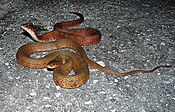 Two salt marsh snakes Two salt marsh snakes
 Blackburnian warbler Blackburnian warbler
|
You are receiving this because you added your name to the subscribers list of the WikiProject Tree of Life. If you no longer wish to receive the newsletter, please remove your name.
Delivered by: MediaWiki message delivery (talk) 23:14, 31 August 2023 (UTC)
WikiProject Tree of Life Newsletter Issue 22

- September 2023—Issue 022
- Tree of Life
- Welcome to the Tree of Life newsletter!
|
|
|
|
| Contest results |
|
The first edition of our new monthly contest had perhaps a little less participation than I hoped for, but it still resulted in a huge amount of content work, mainly focussed on de-stubbing articles on little-known species, although we did also see two GAs for Holozoa and Hypericum perforatum. Overall, over 60 articles were improved, with most going from stubs or redlinks to fully fleshed out articles. The winner this month was Simongraham, who improved 21 articles about spiders, mainly to B and C class, and racked up 70 points, over twice the next highest. Hopefully, we'll continue to see such great work next month, with even more participants and even more articles improved.
|
| September DYKs |
 Republicopteron douseae fossil Republicopteron douseae fossil
 Male Phallichthys fish Male Phallichthys fish
 Mimodactylus reconstruction Mimodactylus reconstruction
 Adult ashy flycatcher Adult ashy flycatcher
|
You are receiving this because you added your name to the subscribers list of the WikiProject Tree of Life. If you no longer wish to receive the newsletter, please remove your name.
Sent by MediaWiki message delivery (talk) 16:23, 1 October 2023 (UTC)
WikiProject Tree of Life Newsletter Issue 23

- October 2023—Issue 023
- Tree of Life
- Welcome to the Tree of Life newsletter!
|
|
| Contest results |
|
The second edition of our monthly contest was even better than the last month, with 80 articles improved spanning the entire tree of life. The winner this month was Quetzal1964, who contributed to 47 articles, mainly relating to marine fish, and racked up 81 points in the process. In second place was simongraham, who got 60 points from 14 articles on various species of jumping spiders. simongraham is still at the top of our overall standings, with 130 points, and Quetzal1964's close behind on 108. The November edition of the contest is now open: feel free to drop by and participate if you work on any TOL-related articles this month. |
| October DYKs |
 Illustration of swordtail mollies Illustration of swordtail mollies
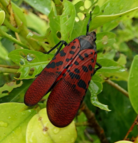 Lycorma meliae Lycorma meliae
 Illustrations of the front foot (A) and hind foot (B) of Diplobune quercyi Illustrations of the front foot (A) and hind foot (B) of Diplobune quercyi
|
You are receiving this because you added your name to the subscribers list of the WikiProject Tree of Life. If you no longer wish to receive the newsletter, please remove your name.
-MediaWiki message delivery (talk) 16:30, 2 November 2023 (UTC)
ArbCom 2023 Elections voter message
Hello! Voting in the 2023 Arbitration Committee elections is now open until 23:59 (UTC) on Monday, 11 December 2023. All eligible users are allowed to vote. Users with alternate accounts may only vote once.
The Arbitration Committee is the panel of editors responsible for conducting the Misplaced Pages arbitration process. It has the authority to impose binding solutions to disputes between editors, primarily for serious conduct disputes the community has been unable to resolve. This includes the authority to impose site bans, topic bans, editing restrictions, and other measures needed to maintain our editing environment. The arbitration policy describes the Committee's roles and responsibilities in greater detail.
If you wish to participate in the 2023 election, please review the candidates and submit your choices on the voting page. If you no longer wish to receive these messages, you may add {{NoACEMM}} to your user talk page. MediaWiki message delivery (talk) 00:44, 28 November 2023 (UTC)
WikiProject Tree of Life Newsletter Issue 24

- November 2023—Issue 024
- Tree of Life
- Welcome to the Tree of Life newsletter!
| Contest results |
|
The third edition of our monthly contest saw Quetzal1964 win for the second month in a row, scoring 68 points from 39 articles about a variety of marine fishes. In second place for the month is Olmagon, who scored 45 points from 10 articles on extinct crustaceans and geckoes. In the overall standings, Quetzal1964 leapfrogged over simongraham into first place, with 176 points from 109 articles; simongraham is now in second place with 136 points from 37 articles. The December edition of the contest is now open: feel free to drop by and participate if you work on any TOL-related articles this month. |
| New newsletter! |
|
Now, this newsletter is technically not new, but I have only recently become aware of its existence and am only a month late, so it still counts. Wikiproject Fungi's Lichen task force has a new newsletter that is very nicely formatted and also features much better writing than this newsletter. Anyone interested in receiving the newsletter can add their name here. |
| November DYKs |
 A bacterium that thrives in the deep ocean A bacterium that thrives in the deep ocean
 Georges Cuvier's reconstruction of Anoplotherium commune Georges Cuvier's reconstruction of Anoplotherium commune
 Paroedura maingoka Paroedura maingoka
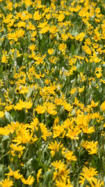 Field of Wyethia amplexicaulis in bloom Field of Wyethia amplexicaulis in bloom
 An adult dwarf pufferfish An adult dwarf pufferfish
 Adult Balkan terrapin Adult Balkan terrapin
 Planocarina marginata, a hyalospheniid amoeba Planocarina marginata, a hyalospheniid amoeba
|
You are receiving this because you added your name to the subscribers list of the WikiProject Tree of Life. If you no longer wish to receive the newsletter, please remove your name.
MediaWiki message delivery (talk) 17:45, 1 December 2023 (UTC)
WikiProject Tree of Life Newsletter Issue 25

- December 2023—Issue 025
- Tree of Life
- Welcome to the Tree of Life newsletter!
|
|
|
|
| Contest results |
|
And so ends the fourth edition of the monthly rolling contest, as well as the 2023 Tree of Life Contest as a whole. This month saw simongraham win with a very impressive 120 points from 27 articles. Quetzal1964 was second with 74 points from 37 articles. The annual contest was a close race between simongraham and Quetzal1964; simongraham won first place with 256 points from 64 articles, and Quetzal1964 was second with 250 points from 146 articles. Snoteleks was third with 79 points from 33 articles. Congratulations to everyone who won this year and my gratitude to everyone else who helped raise the quality of articles in our little corner of Misplaced Pages this year. Additionally, a very Happy New Year to everyone in the project and here's looking forward to continuing our good work in 2024! |
| December DYKs |
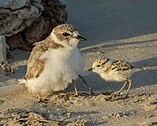 Snowy plover with chicks Snowy plover with chicks
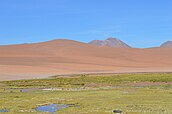 Bofedales in the foreground Bofedales in the foreground
 Adult female Varroa mite Adult female Varroa mite
 Dennstaedtia christophelii fossil frond Dennstaedtia christophelii fossil frond
|
You are receiving this because you added your name to the subscribers list of the WikiProject Tree of Life. If you no longer wish to receive the newsletter, please remove your name.
MediaWiki message delivery (talk) 10:57, 1 January 2024 (UTC)
WikiProject Tree of Life Newsletter Issue 26

- January and February 2024—Issue 026
- Tree of Life
- Welcome to the Tree of Life newsletter!
|
|
| News at a glance |
|
| January DYKs |
|
| February DYKs |
|
You are receiving this because you added your name to the subscribers list of the WikiProject Tree of Life. If you no longer wish to receive the newsletter, please remove your name.
MediaWiki message delivery (talk) 12:53, 1 March 2024 (UTC)
WikiProject Tree of Life Newsletter Issue 27

- March and April 2024—Issue 027
- Tree of Life
- Welcome to the Tree of Life newsletter!
| News at a glance |
|
| March DYKs |
|
| April DYKs |
|
You are receiving this because you added your name to the subscribers list of the WikiProject Tree of Life. If you no longer wish to receive the newsletter, please remove your name.
MediaWiki message delivery (talk) 05:21, 6 May 2024 (UTC)
Editor experience invitation
Hi LittleLazyLass :) I'm looking for experienced editors to interview here. Feel free to pass if you're not interested. Clovermoss🍀 (talk) 21:22, 25 June 2024 (UTC)
Introduction to contentious topics

You have recently edited a page related to gender-related disputes or controversies or people associated with them, a topic designated as contentious. This is a brief introduction to contentious topics and does not imply that there are any issues with your editing.
A special set of rules applies to certain topic areas, which are referred to as contentious topics. These are specially designated topics that tend to attract more persistent disruptive editing than the rest of the project and have been designated as contentious topics by the Arbitration Committee. When editing a contentious topic, Misplaced Pages’s norms and policies are more strictly enforced, and Misplaced Pages administrators have special powers in order to reduce disruption to the project.
Within contentious topics, editors should edit carefully and constructively, refrain from disrupting the encyclopedia, and:
- adhere to the purposes of Misplaced Pages;
- comply with all applicable policies and guidelines;
- follow editorial and behavioural best practice;
- comply with any page restrictions in force within the area of conflict; and
- refrain from gaming the system.
Editors are advised to err on the side of caution if unsure whether making a particular edit is consistent with these expectations. If you have any questions about contentious topics procedures you may ask them at the arbitration clerks' noticeboard or you may learn more about this contentious topic here. You may also choose to note which contentious topics you know about by using the {{Ctopics/aware}} template.
Also, plese have a look also at the information at this page, which appears when editing J. K. Rowling. SandyGeorgia (Talk) 14:29, 26 June 2024 (UTC)
Your GA nomination of Laquintasaura
Hi there, I'm pleased to inform you that I've begun reviewing the article Laquintasaura you nominated for GA-status according to the criteria. ![]() This process may take up to 7 days. Feel free to contact me with any questions or comments you might have during this period. Message delivered by ChristieBot, on behalf of Jens Lallensack -- Jens Lallensack (talk) 02:23, 30 June 2024 (UTC)
This process may take up to 7 days. Feel free to contact me with any questions or comments you might have during this period. Message delivered by ChristieBot, on behalf of Jens Lallensack -- Jens Lallensack (talk) 02:23, 30 June 2024 (UTC)
Your GA nomination of Laquintasaura
The article Laquintasaura you nominated as a good article has passed ![]() ; see Talk:Laquintasaura for comments about the article, and Talk:Laquintasaura/GA1 for the nomination. Well done! If the article is eligible to appear in the "Did you know" section of the Main Page, you can nominate it within the next seven days. Message delivered by ChristieBot, on behalf of Jens Lallensack -- Jens Lallensack (talk) 19:21, 21 July 2024 (UTC)
; see Talk:Laquintasaura for comments about the article, and Talk:Laquintasaura/GA1 for the nomination. Well done! If the article is eligible to appear in the "Did you know" section of the Main Page, you can nominate it within the next seven days. Message delivered by ChristieBot, on behalf of Jens Lallensack -- Jens Lallensack (talk) 19:21, 21 July 2024 (UTC)
Motokare Retry
Thank you for reviewing Motokare Retry for Did you know?. I'm currently trying to create more articles on shōjo manga series, so look forward to them! lullabying (talk) 03:01, 29 July 2024 (UTC)
DYK nomination of Asiatyrannus
![]() Hello! Your submission of Asiatyrannus at the Did You Know nominations page has been reviewed, and some issues with it may need to be clarified. Please review the comment(s) at your nomination's entry and respond there at your earliest convenience. Thank you for contributing to Did You Know! Z1720 (talk) 00:26, 11 August 2024 (UTC)
Hello! Your submission of Asiatyrannus at the Did You Know nominations page has been reviewed, and some issues with it may need to be clarified. Please review the comment(s) at your nomination's entry and respond there at your earliest convenience. Thank you for contributing to Did You Know! Z1720 (talk) 00:26, 11 August 2024 (UTC)
- Your nomination has been marked for closure due to a lack of response. If you wish to save it before it closes, please comment there immediately. Best of luck! BlueMoonset (talk) 19:30, 20 August 2024 (UTC)
DYK for Laquintasaura
On 22 August 2024, Did you know was updated with a fact from the article Laquintasaura, which you recently created, substantially expanded, or brought to good article status. The fact was ... that the discovery of Laquintasaura challenged the idea that early dinosaurs could not survive in equatorial regions? The nomination discussion and review may be seen at Template:Did you know nominations/Laquintasaura. You are welcome to check how many pageviews the nominated article or articles got while on the front page (here's how, Laquintasaura), and the hook may be added to the statistics page after its run on the Main Page has completed. Finally, if you know of an interesting fact from another recently created article, then please feel free to suggest it on the Did you know talk page.
RoySmith (talk) 00:02, 22 August 2024 (UTC)
DYK for Asiatyrannus
On 3 September 2024, Did you know was updated with a fact from the article Asiatyrannus, which you recently nominated. The nomination discussion and review may be seen at Template:Did you know nominations/Asiatyrannus. You are welcome to check how many pageviews the nominated article or articles got while on the front page (here's how, Asiatyrannus), and the hook may be added to the statistics page after its run on the Main Page has completed. Finally, if you know of an interesting fact from another recently created article, then please feel free to suggest it on the Did you know talk page.
BorgQueen (talk) 03:44, 3 September 2024 (UTC)
ArbCom 2024 Elections voter message
Hello! Voting in the 2024 Arbitration Committee elections is now open until 23:59 (UTC) on Monday, 2 December 2024. All eligible users are allowed to vote. Users with alternate accounts may only vote once.
The Arbitration Committee is the panel of editors responsible for conducting the Misplaced Pages arbitration process. It has the authority to impose binding solutions to disputes between editors, primarily for serious conduct disputes the community has been unable to resolve. This includes the authority to impose site bans, topic bans, editing restrictions, and other measures needed to maintain our editing environment. The arbitration policy describes the Committee's roles and responsibilities in greater detail.
If you wish to participate in the 2024 election, please review the candidates and submit your choices on the voting page. If you no longer wish to receive these messages, you may add {{NoACEMM}} to your user talk page. MediaWiki message delivery (talk) 00:30, 19 November 2024 (UTC)

